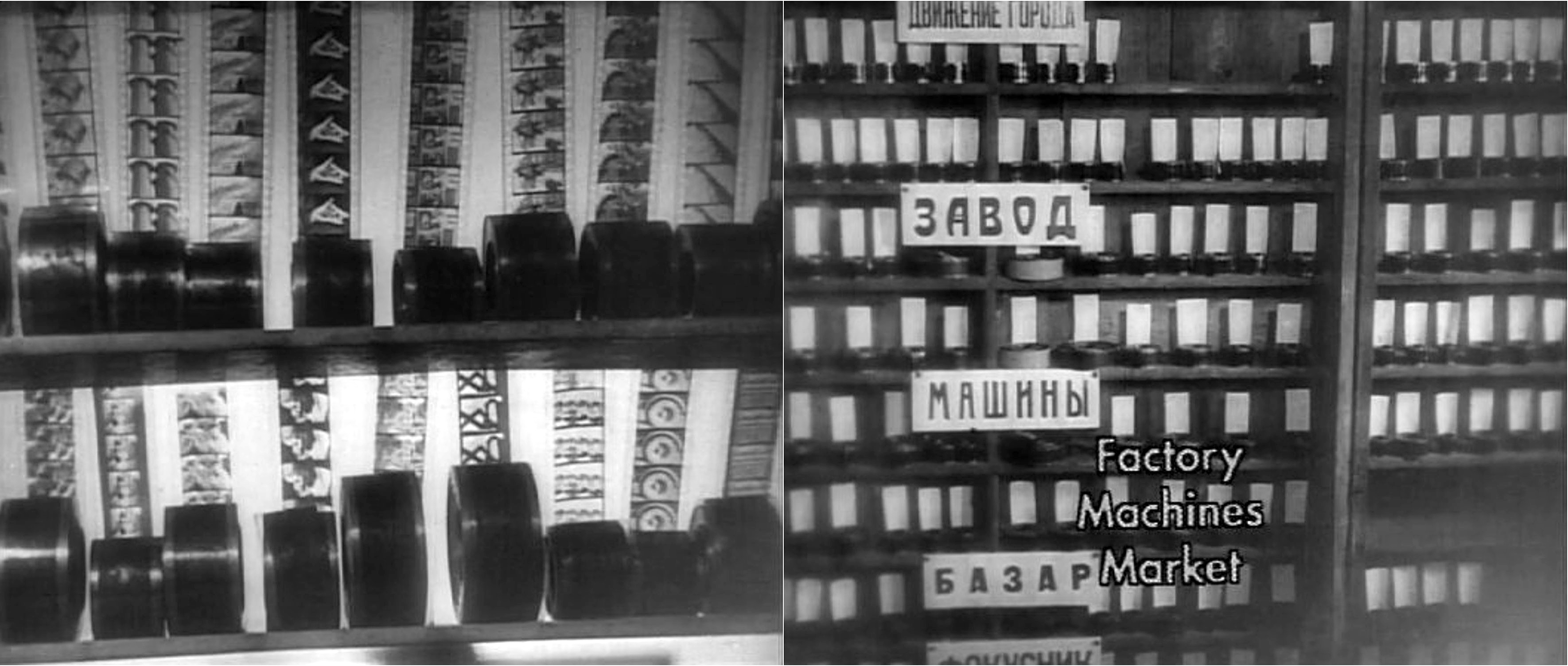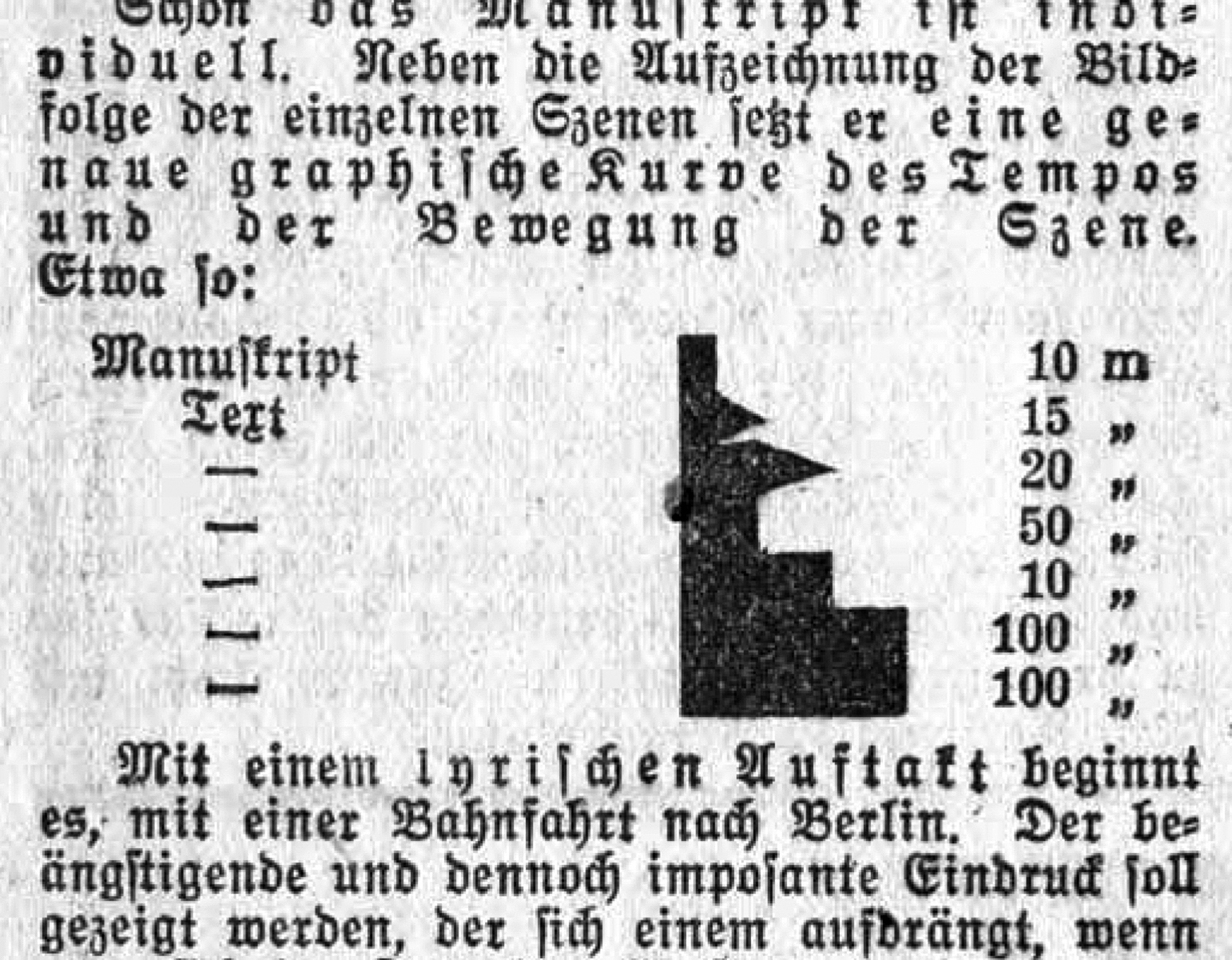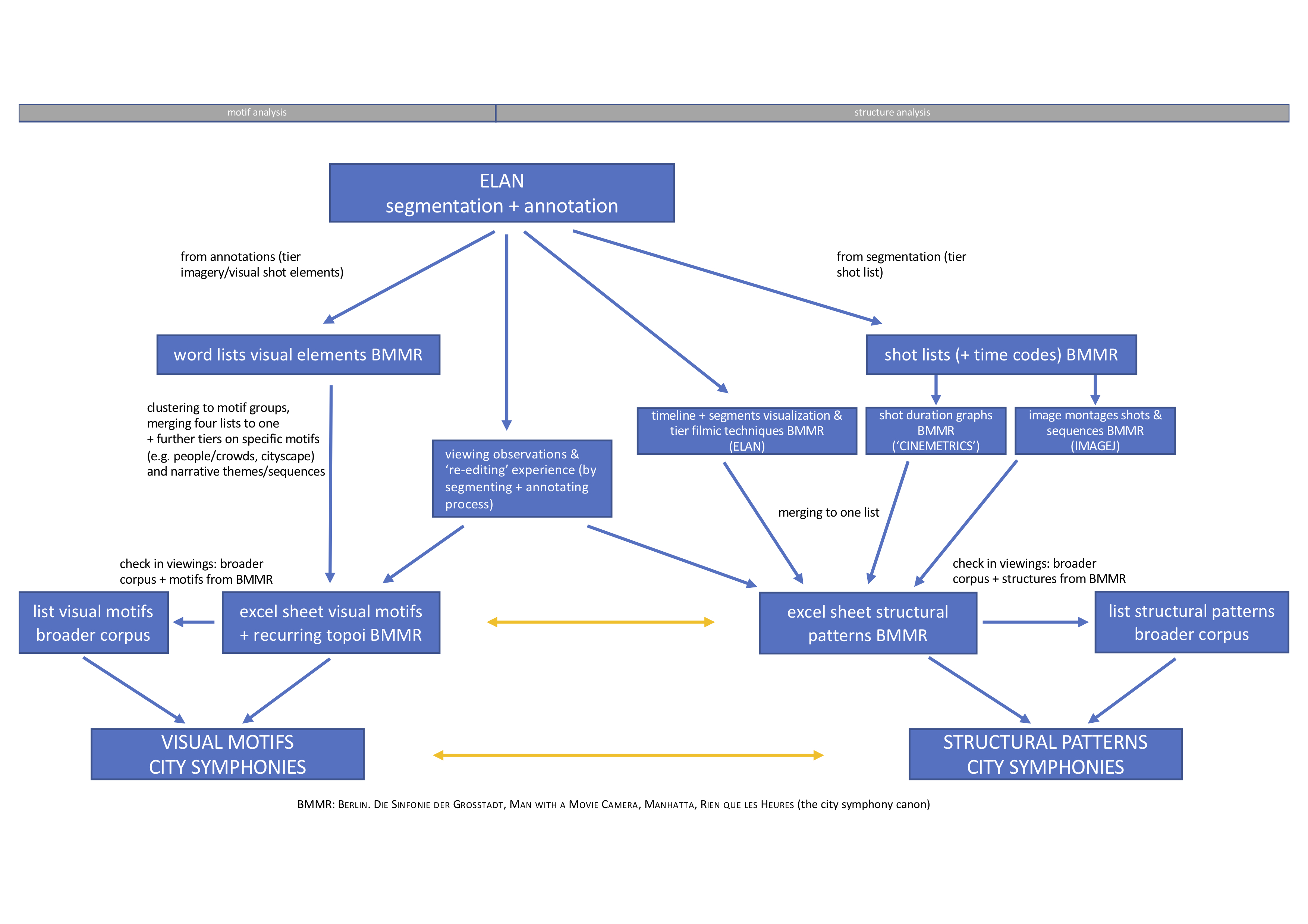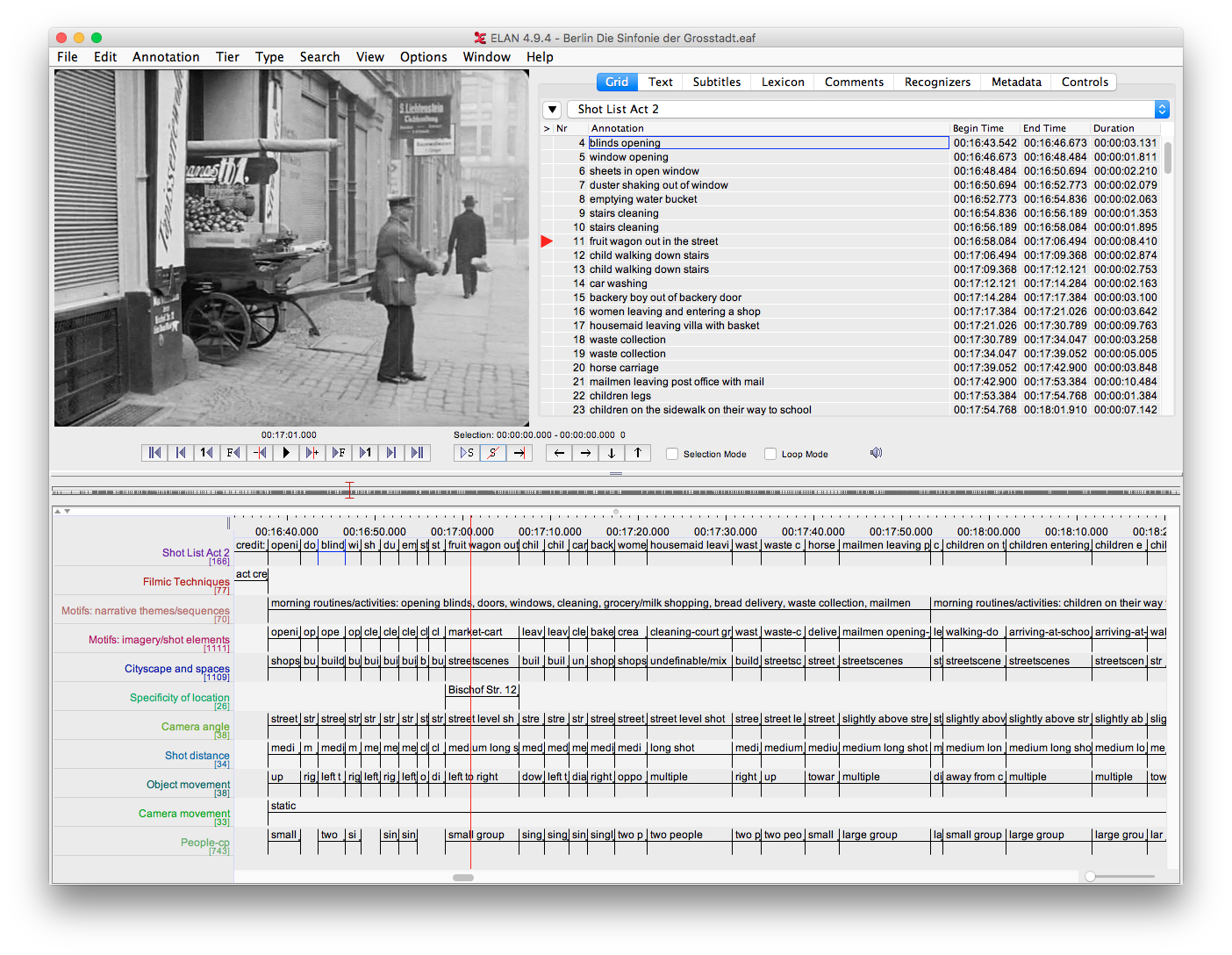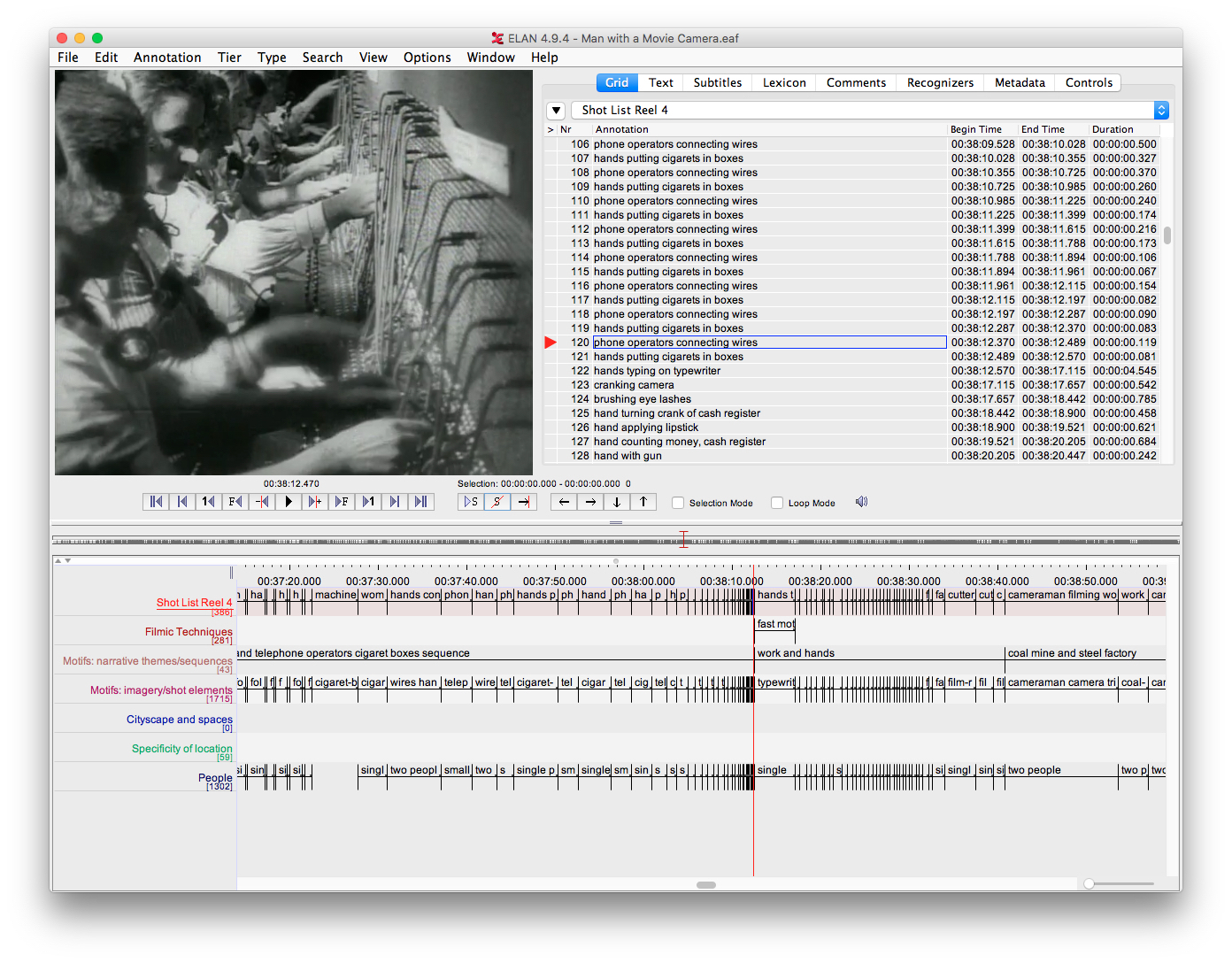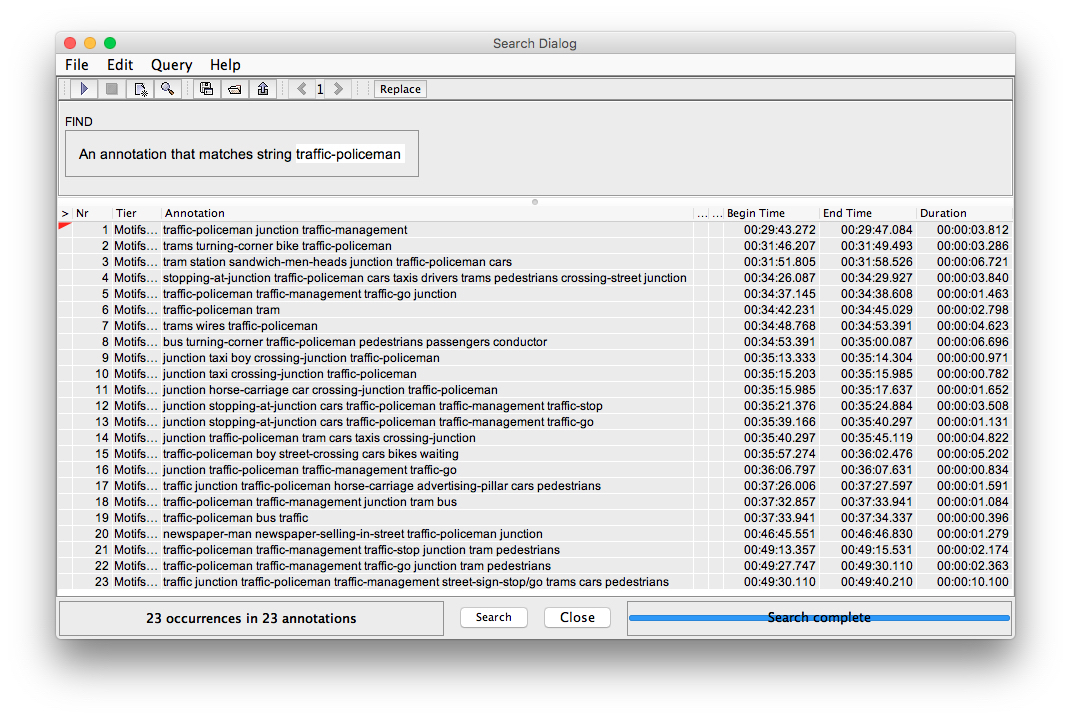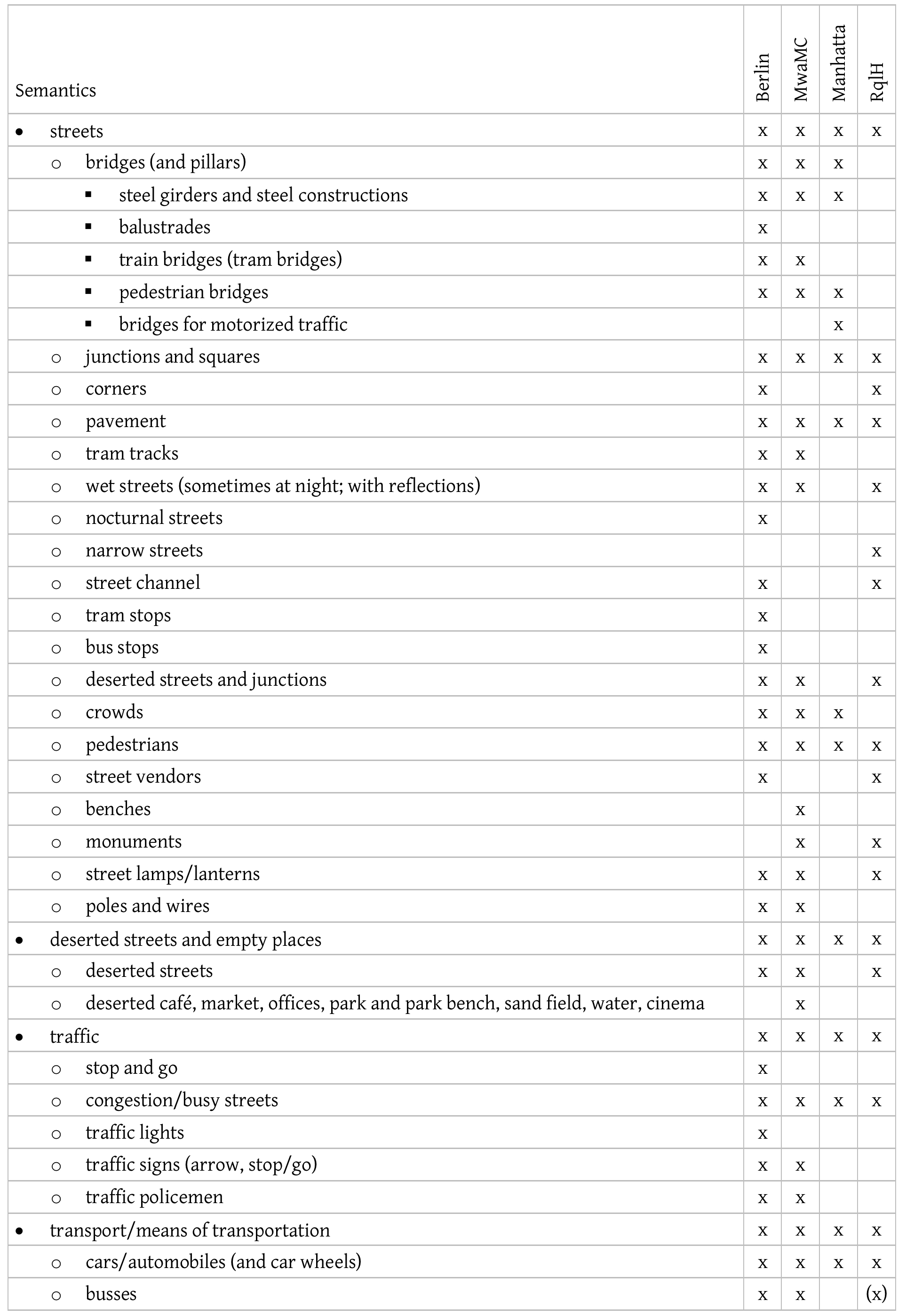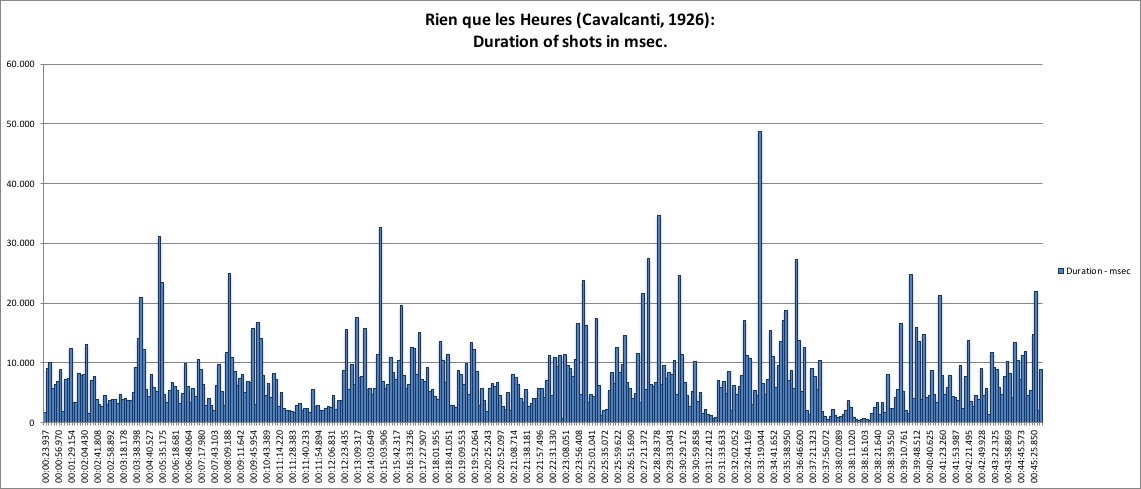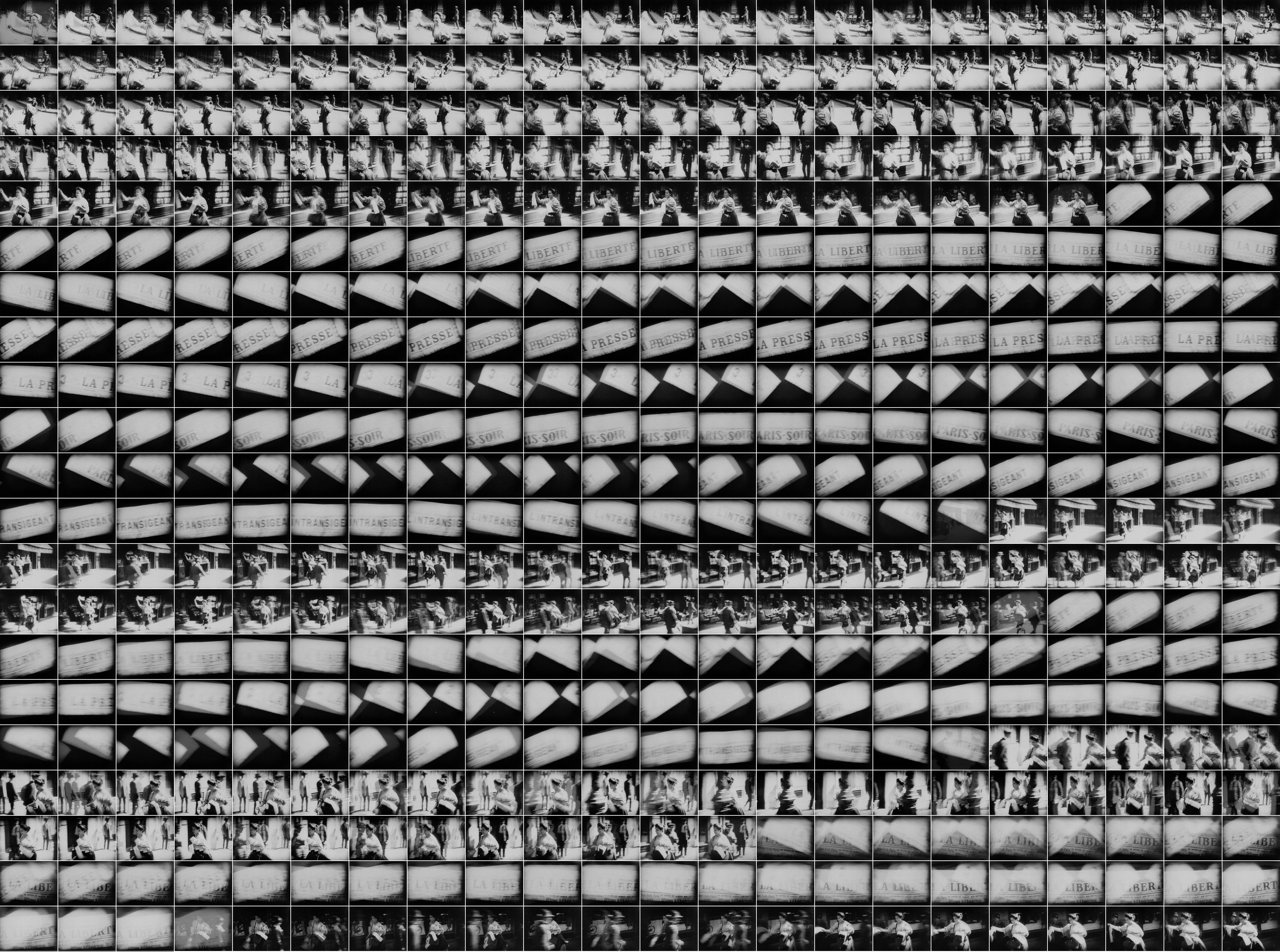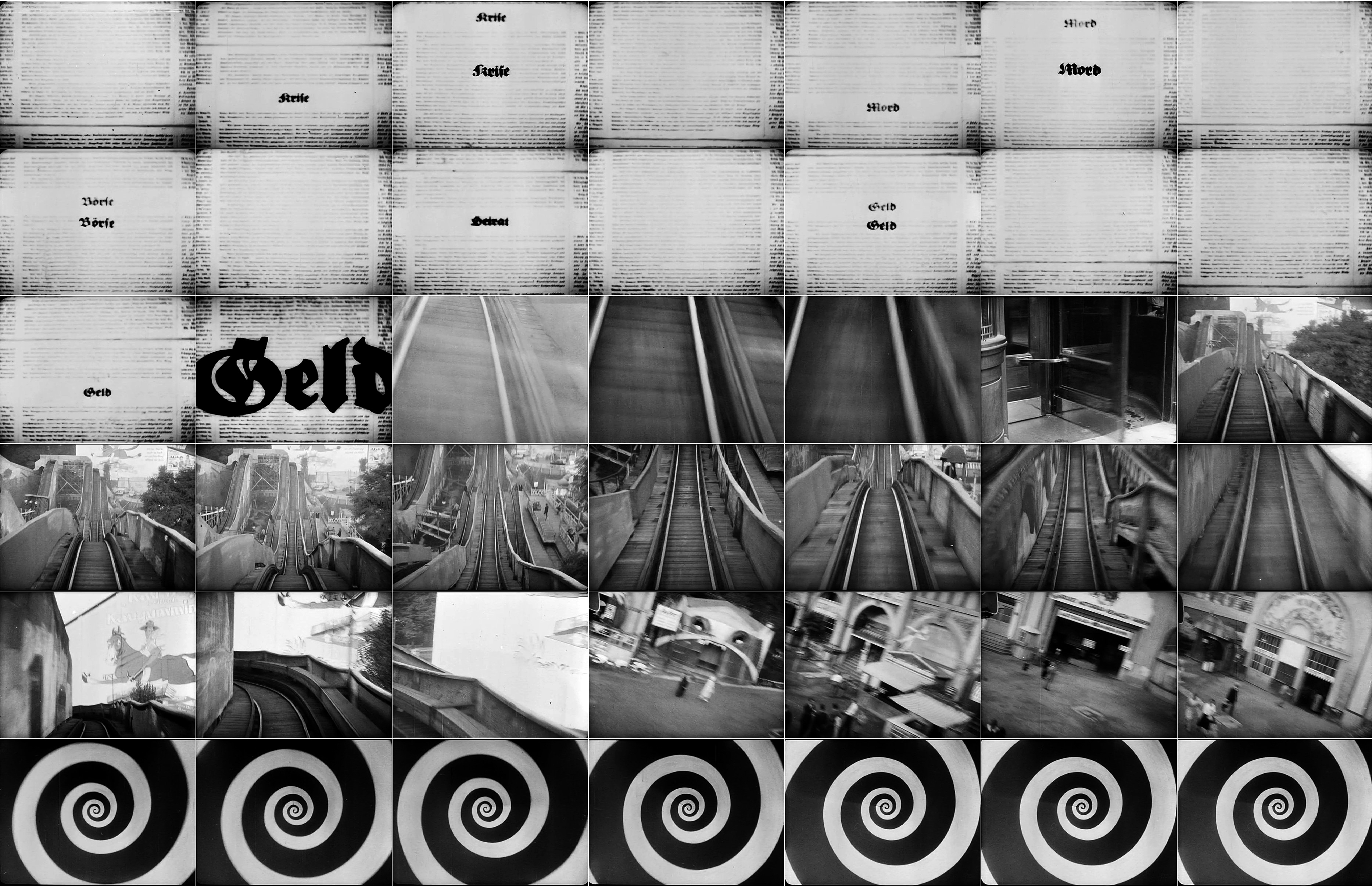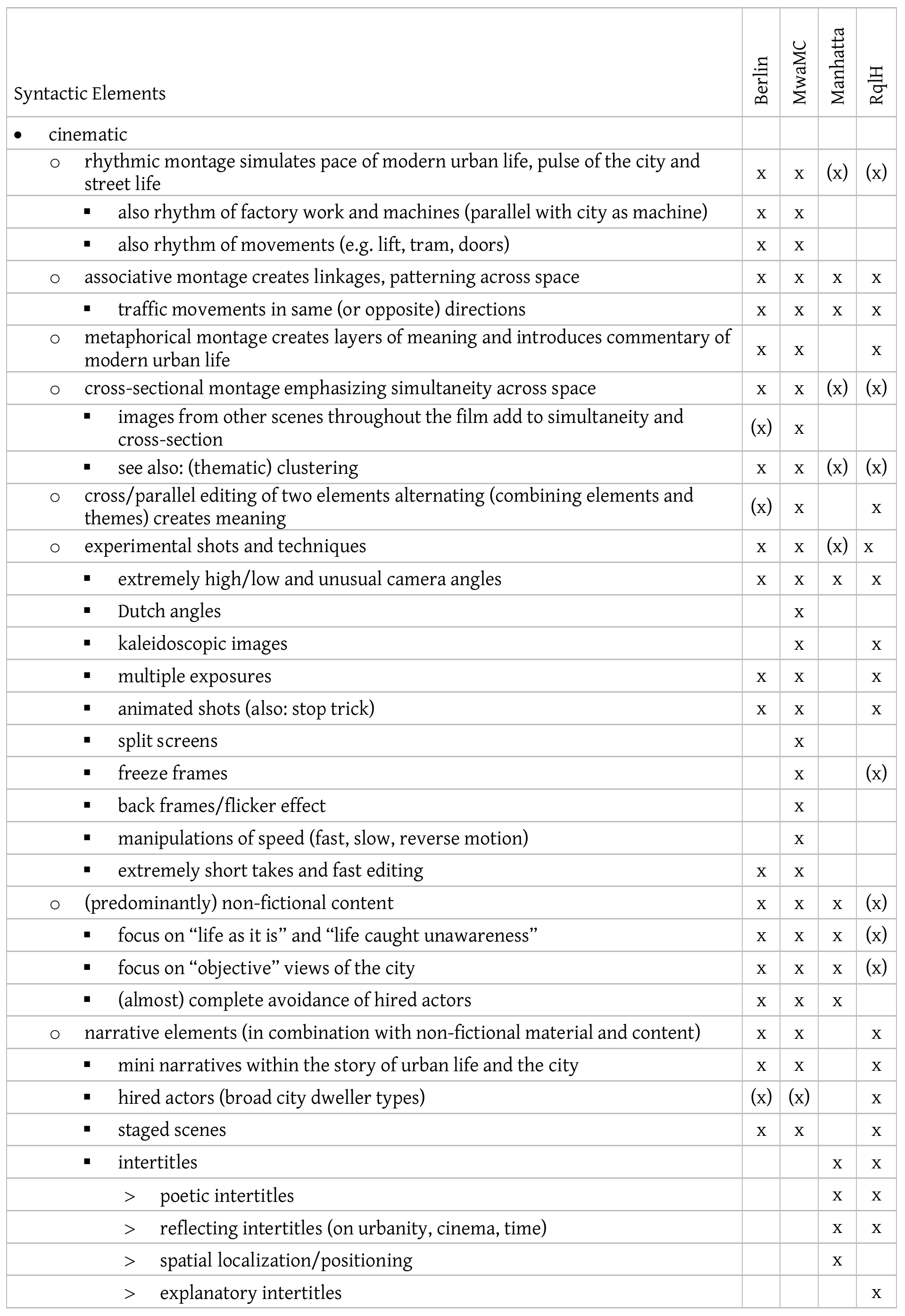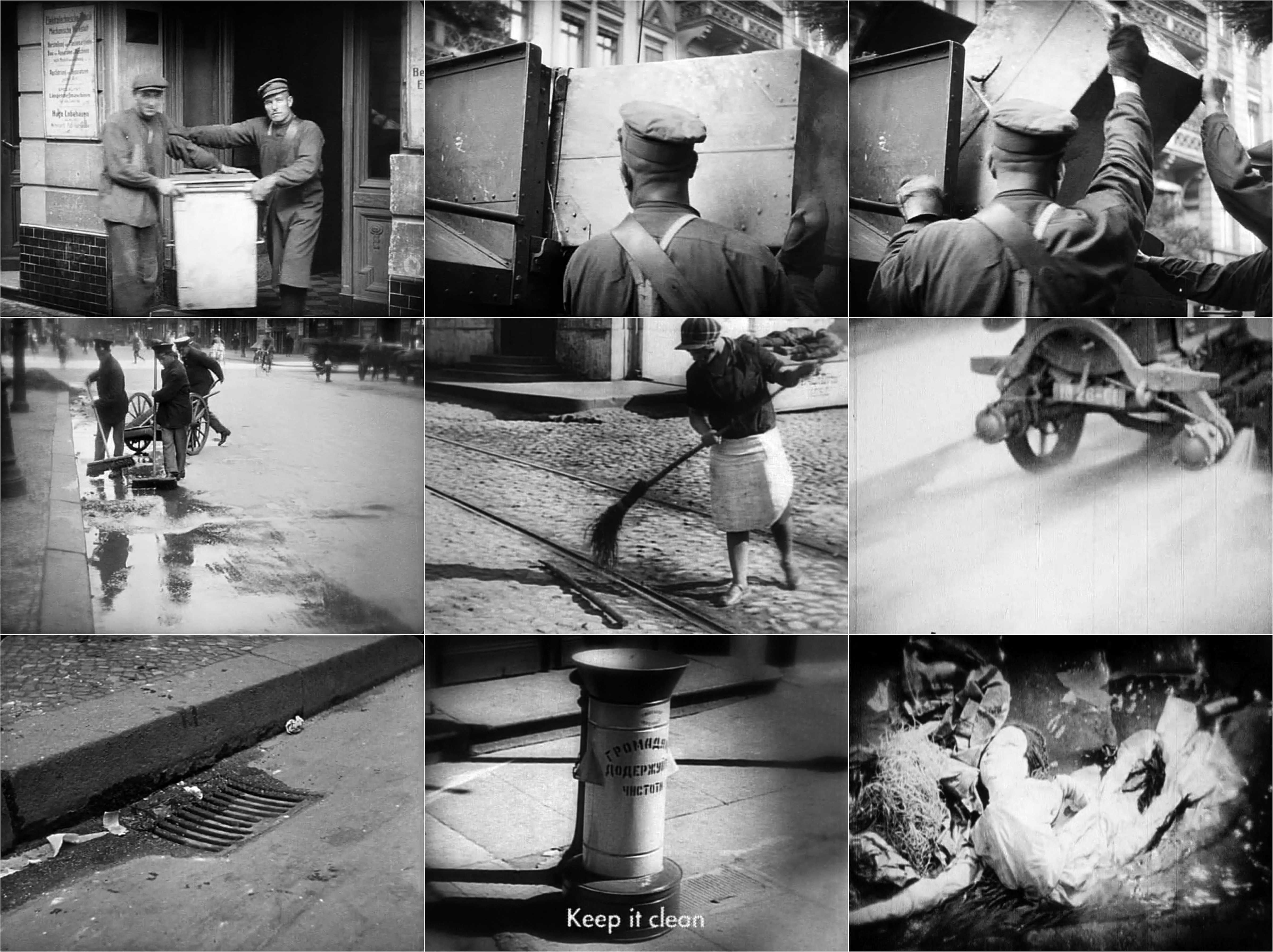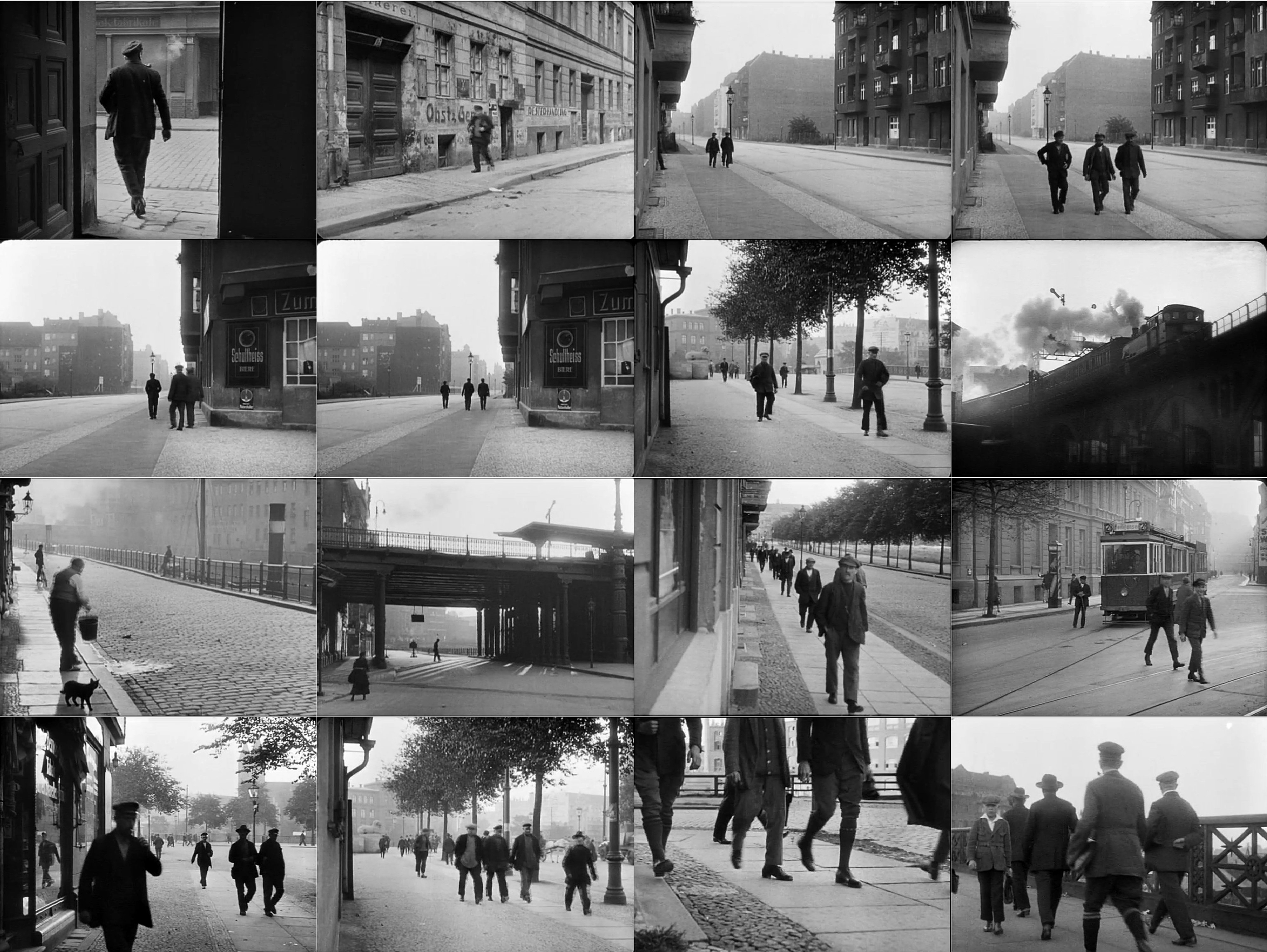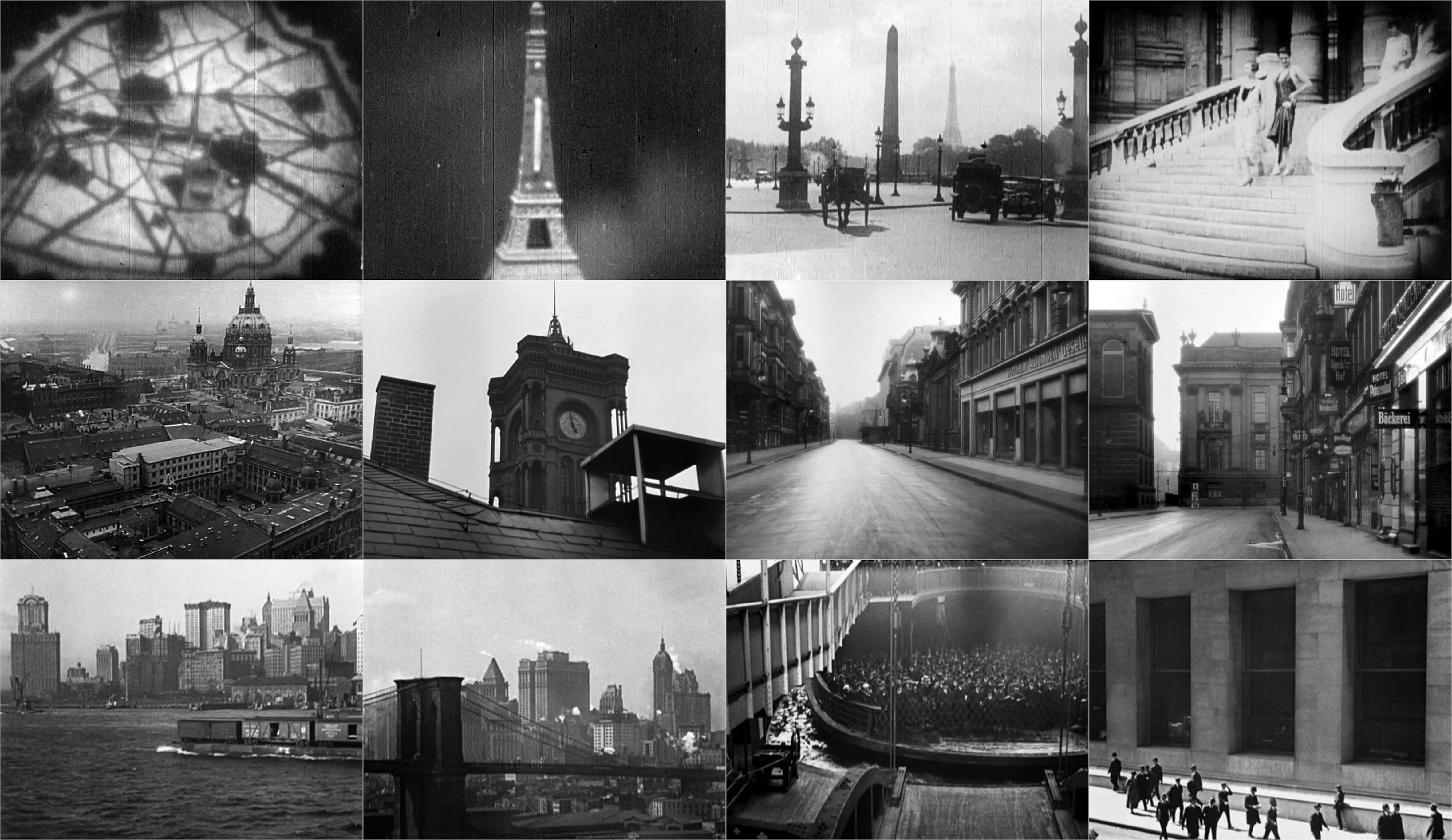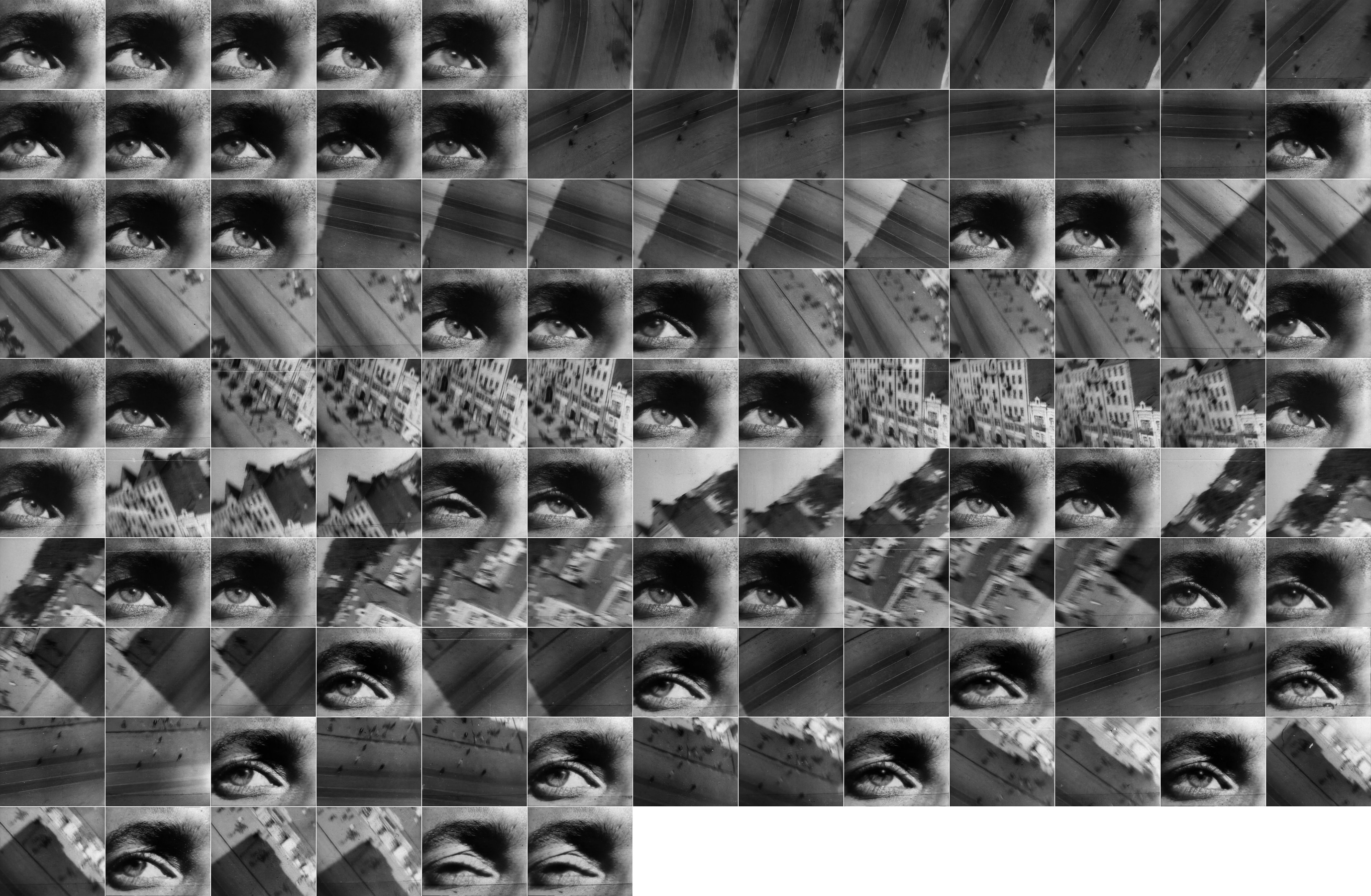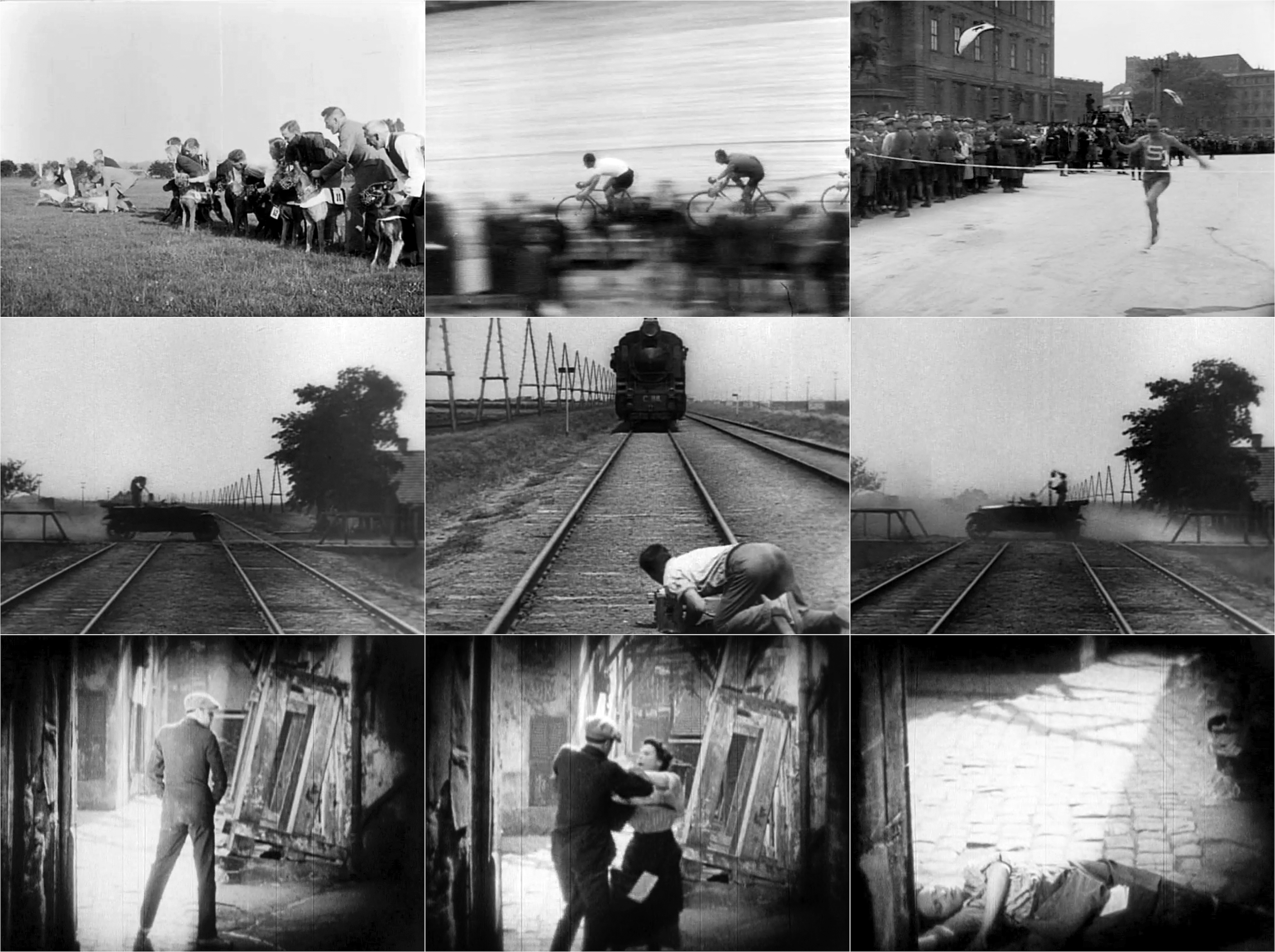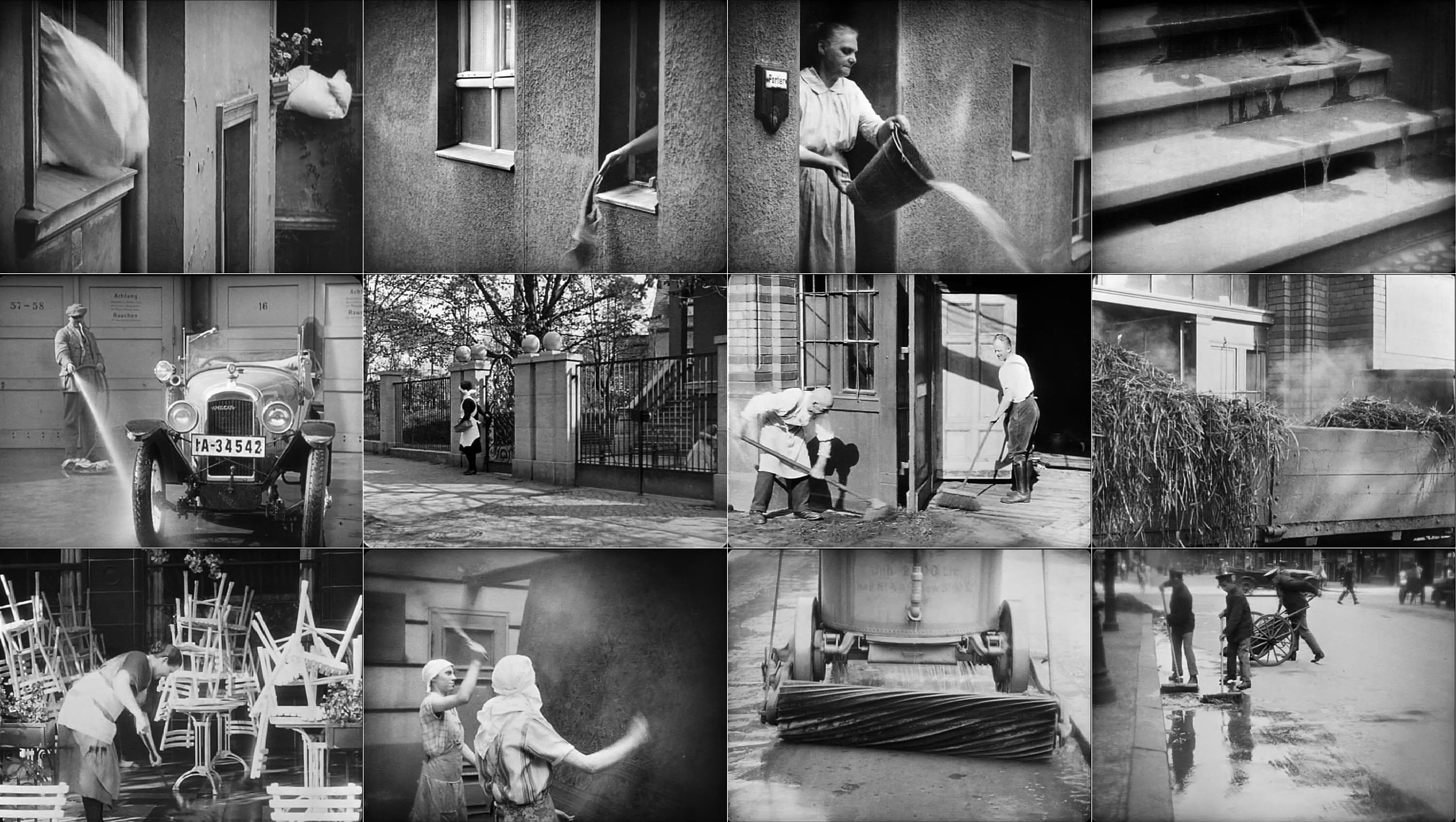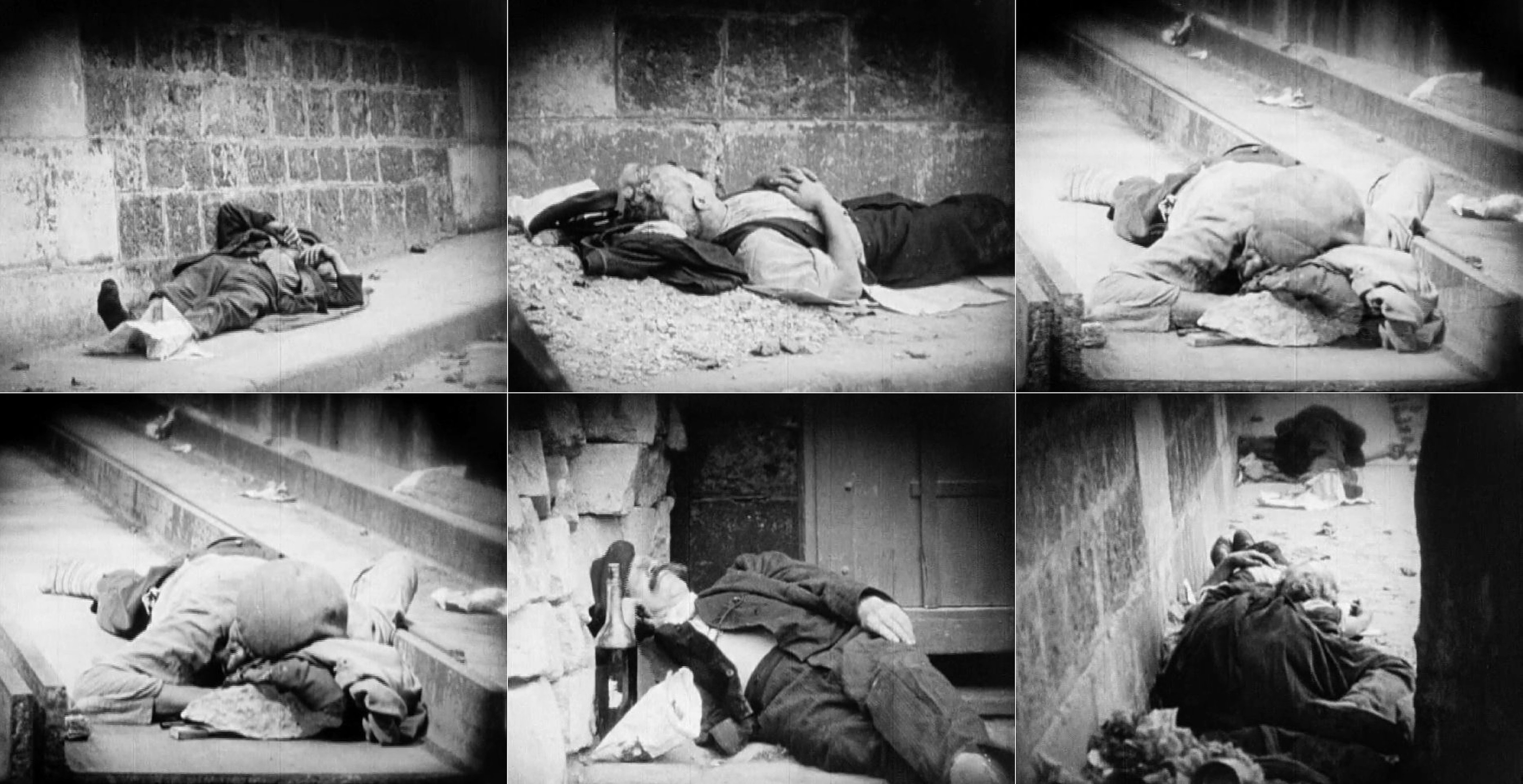2020
Volume 14 Number 4
Abstract
The 1920s and 1930s saw the rise of the city symphony, a film phenomenon
of experimental-documentary city films that took the modern metropolis
as their protagonist and presented it in its multiple facets and
kaleidoscopic nature. While Ruttmann’s Berlin. Die Sinfonie der
Grosstadt (1927) and Vertov’s Chelovek s kinoapparatom (1929) gained canonical status
and exert a considerable influence on filmmaking to this very day, the
city symphony has remained a somewhat downplayed and neglected
phenomenon in film history. Indeed, besides the handful of well-known
titles, there have been more than eighty films made around the globe,
many of which fell into oblivion and have received little or no
scholarly attention at all. Moreover, even the canonical examples have
never systematically and structurally been analyzed in detail in a
comparative way. The result is the lack of a sophisticated and clear
definition of the city symphony, based on both the canonical films and
the greater city symphony corpus. My research sets in at this point,
addressing the conspicuous absence of an analysis of city symphony
characteristics. It does so by making use of a combined methodology of
traditional film analysis methods and digital tools. This article
reflects on the methodology applied and tools chosen and put into
practice to study and analyze the visual material of city symphonies,
which with their highly complex structure, dense imagery, and themes
as well as their experimental techniques and striking editing
patterns, are a perfect fit for a computational film analysis.
Particularly, the digital film/video annotation software ELAN, the
Cinemetrics method, a bar chart representation of shot lengths, and
the grid visualizations of multiple film frames created with ImageJ
play a role in this case study, which also broaches the aspect and
benefits of manual digital analysis.
City Symphonies and a (Half‑)Blind Spot in Film History
This article is based on my PhD dissertation Rewinding the City Symphony: Historiography, Visual Motifs and
Structural Patterns of Interwar City Symphony Films
(Ghent University, 2018) and reflects on the methodology applied for
the analysis of visual material. In this regard, what follows can be
considered as a research report – with a special focus on the methods
chosen and put into practice to study and analyze city symphonies,
making use of digital humanities tools in a film studies research.
Particularly, the digital film/video annotation software ELAN, the
Cinemetrics method, a bar chart representation of shot lengths, and
the grid visualizations of multiple film frames created as image
montages with ImageJ play a role in this case study.
City symphonies are experimental-documentary city films of the 1920s and
1930s that take the modern metropolis as their protagonist and present
it in its multiple facets and kaleidoscopic nature. Often described as
cross-section or montage films (e.g.
Kracauer, 1947;
Weihsmann,
1997;
Koeck and Roberts,
2010), they combine a great number of visual urban motifs
and themes with a highly complex editing structure. The most famous
examples are Walther Ruttmann’s
Berlin. Die
Sinfonie der Grosstadt (
Berlin,
Symphony of a Great City, 1927) and Dziga Vertov’s
Chelovek s kinoapparatom (
Man with a Movie Camera, 1929). To this
day, these films exert a considerable influence on filmmaking and the
cinematic language in general. Recent city films such as
London Symphony (Alex Barrett, 2017),
Symphony of Now (Johannes Schaff,
2018), or Mark Cousins’s
I am Belfast
(2015) and
Stockholm My Love (2017) are
just the most obvious indications for this impact and popularity.
However, despite the ongoing (or reviving) influence on the production of
urban films and the canonical status of Ruttmann and Vertov’s films,
the city symphony has remained a somewhat downplayed and neglected
phenomenon in film history. While, on the one hand, in fact, it
is considered as a crucial part of canonical film
history today and as a basis for the fast-growing scholarship on city
films in general (see e.g.
Bordwell and
Thompson, 2019;
Nowell-Smith, 1997;
Koeck and
Roberts, 2010;
Mazierska and
Rascaroli, 2003), on the other hand, it has never really
been more than “a colorful footnote to film
history”
[
Kinik 2008, 16]. Indeed, besides the handful of
well-known titles, which include also
Manhatta (Paul Strand and Charles Sheeler, 1921) and
Rien que les Heures (
Nothing But Time, Alberto Cavalcanti,
1926), there have been more than eighty films made around the globe in
the interwar period.
[1] Many of these films fell into
oblivion and have received little or no scholarly attention at all.
Hence, the city symphony phenomenon was much more complex, widespread
and diverse than generally assumed and acknowledged in film
historiography. Moreover, even the canonical examples have never
systematically and structurally been analyzed in detail in a
comparative way. While there have been studies on individual titles,
publications putting the city symphony in context of the broader field
of the city film, and a few attempts mentioning and discussing a group
of films together and highlighting
some features (rough
descriptions and short characterizations), a comprehensive analysis
concerning shared visual and structural qualities and the central
characteristics of the city symphony has never been made.
[2] The result is the lack of a sophisticated
and clear definition of the city symphony, based on both the canonical
films and the greater city symphony corpus, that is still missing
after decades of film studies. This blind spot is striking since it
does not concern obscure films from
the edge of film
history, but a vast international phenomenon and films that were
highly celebrated at their time and – once more – whose popularity and
influence are recognizable to this very day.
What constitutes the city symphony looking at shared elements of the
canon films Berlin, Man with a Movie Camera, Rien que
les Heures and Manhatta as
well as the bigger corpus? What are the visual motifs, formal and
structural features of the city symphony? My research sets in at this
point, addressing the conspicuous absence of an analysis of city
symphony characteristics, as it delves deeper into the phenomenon by
examining the films themselves.
A Perfect Fit: City Symphonies and Computational Analysis
Methods
With their highly complex structure, dense imagery and themes as well as
their experimental techniques and striking editing patterns, city
symphonies are a perfect fit for a computational film analysis, which
in segmentations and annotations allows to structurally, precisely and
in detail identify individual elements (such as motifs), break down
the complexity of these films into separate component parts, and makes
it possible to see how different aspects are linked to each other.
Moreover, city symphonies do not only share the fractured nature and
overwhelming, chaotic impressions with the modern city
[3] – their very
subject matter – they also relate to the database logic of the
computer. According to
Manovich
(2001), the database as a cultural form introduced the
“correlate” to the linearity and
cause-and-effect trajectory of the logic of the narrative and a new
way of structuring our experiences, presenting the world as a list of
items and refusing to order this list. Every item possesses the same
significance as any other. In addition, Manovich explicitly describes
Man with a Movie Camera as “perhaps the most
important example of a database imagination in modern media
art,” which anticipated the database logic of digital
media in presenting an almost “linear printout
[...] of a database” and “a catalog
of subjects that one could expect to find in a city of the
1920s,” supplemented with “the most
amazing catalog of film techniques.”
[
Manovich 2001, 241]
[4]
Similarly (and following Manovich’s ideas), Cowan integrates
Ruttmann’s
Berlin and the city symphony
form in general in the same tradition of the database logic as it
emphasizes “paradigmatic over syntagmatic
relations, presenting the world as an inventory of possible
choices rather than a causal chain of narrative events”
[
Cowan 2014, 60]. Moreover, apart from their form
underlining and embracing the database logic,
[5] both
Man
with a Movie Camera and Berlin were based on actual
databases documenting city life. Vertov, as we can see in his film,
arranged his film reels on shelves according to keywords, such as
“city traffic,”
“factory,”
“machines,” and “market,” while Ruttmann used a card
catalogue system for organizing his footage (see Figure 1 and Figure
2). In this regard, a computational study of city symphonies also
comprises a self-reflexive moment as it shares its database logic with
its very subject of research and aims to build a catalogue or database
of city symphony features itself by looking at individual component
parts of the films as equal items.
Finally, city symphonies are a perfect case study for exploring the
possibilities and applications of computational methods for film
analysis as they allow for a variety of research questions, including
the issue of film style (editing patterns, experimental techniques
etc.), questions of content (motifs, themes), and specific aspects
concerning the representation of people and the city.
Film Analysis Step 1: ELAN
For the study of visual motifs and structural patterns of interwar
city symphonies, I made use of the digital video annotation
software ELAN.
[6] More
precisely, ELAN formed the center and very fundament of the
bottom-up analysis, based on which further analysis steps
followed in terms of data evaluation and visualizations (see
Figure 3).
Created by the Language Archive of the Max Planck Institute for
Psycholinguistics in the Netherlands, ELAN was originally
developed for a community of linguists and communication
scholars. Nevertheless, this free and open-source tool can also
be used in film studies and for visual and structural analysis,
as it belongs to a group of professional video annotation
programs that support manual annotation tasks, based on a tiered
or layered timeline approach to segmentation and annotation. Put
differently, a media stream can be divided into multiple
segments grouped in categories. ELAN supports this via
horizontal rows (or tiers) organized vertically under each
other. Each tier corresponds to an annotation type or category
the user can define herself according to specific needs and
research questions. Within the individual tiers, segments can be
defined and annotated, which appear in a horizontal, time-based
distribution on the particular tier (see Figure 4).
[7]
As single stand-alone platform, ELAN facilitates the analysis of
visual material by providing the digital video file (the film),
the timeline, segmentation, and annotations in one and the same
platform, thereby directly linking these elements to each other
so that jumping in the timeline (respectively a tier) brings one
to the corresponding fragment and vice versa. What you see is
directly where and what you segment and annotate. Moreover, it
provides a visualization of the film, its timeline, and the
segments and annotations, thus making visible in the same
platform the film picture and a visualization of its
analysis.
There are other digital video annotation tools, including Anvil,
Advene, and Lignes de temps, which follow a comparable approach
as ELAN and allow for similar analysis operations and
options.
[8] However, a brief
exercise with these four software programs demonstrated that
ELAN was the most convenient and most suitable for my research
endeavor. This concerned the media player with its playback rate
possibilities, its media control panel, and viewing options as
well as the handling and viewing possibilities of the timeline,
tiers, and annotation sections. More precisely, ELAN facilitates
to speed up the playback rate of the video up to 200% and slow
it down to 10%. Moreover, the media control panel supports to
jump ahead or back in the video (and the timeline) from one
second down to one millisecond,
[9]
while the video image can also be enlarged and presented in a
separate window, unlocked from the control panel and annotation
sections. In addition, the tiers can be zoomed in and out, which
makes also the segmentation and annotation of extremely small or
short segments in a detailed and precise way possible. Indeed,
ELAN was also the most convenient of the four tested tools in
the manner how it facilitates the creation of segments and the
adding of annotations and comments in a very detailed way. As
the focus of the analysis in my case lay both on the visual
content and structural patterns of city symphonies, the latter
for which montage plays a key role, a shot-based segmentation
and annotation was the desired goal. In this regard, with its
slow playback options of the video and zoom-in display of the
timeline and tiers, ELAN allowed to identify and mark also
extremely short takes of only a few (or even a single) frame(‑s)
and analyze sections of extremely fast editing. In fact, city
symphonies are often marked by such a fast and rhythmic editing,
for which
Berlin’s opening sequence
with a train approaching the city and
Man
with a Movie Camera’s cross-cutting of telephone
operators and a factory worker putting cigarettes into boxes are
emblematic examples (see Figure 5 and Figure 6). ELAN’s option
to set a shot change on the timeline linked to the picture
(while the film is playing or pausing) in a very detailed and
controlled way made it possible to create a shot-based
segmentation also of these more challenging parts of city
symphonies that one can go back to and replay at every point on
the timeline as often as necessary.
[10]
Moreover, its flexibility of defining multiple tiers according to
one’s own research purposes, the option to use the same
(self-defined) template of tiers as a blueprint for various
films, the possibility of creating and using predefined
vocabularies for individual tiers,
[11] and the combination of these
aspects were advantages of ELAN. Another benefit is the tool’s
search function, which allows to easily find a specific fragment
– without scrolling, clicking, or reeling through the film – and
get a list of all annotations, shots or segments including a
particular search word. In this way, if a certain consistency is
applied in the annotation process, one can, for instance, find
all the shots containing a traffic policeman in
Berlin in a single search request
(see Figure 7). Finally, ELAN’s complete and detailed user
manual, its support of various digital video file formats and
codecs, its export options, and its computer system requirements
as an actively supported and maintained tool contributed to the
decision to work with this software.
For the analysis of city symphonies, I manually segmented the four
films
Berlin,
Man with a Movie Camera,
Rien que les Heures, and
Manhatta and added descriptions, words, and
keywords to the segments in a number of tiers focusing on motifs
and visual elements, bigger thematic sequences, people, the
cityscape, specific locations, and filmic techniques such as
fades, multiple exposures, split screens, and fast motion (see
Figure 4).
[12] As mentioned above,
segmenting in this case meant a very fine-grained segmentation
at shot level as the basis for adding annotations to the
individual tiers.
[13] Hence,
I identified all shots and marked all shot changes,
[14] and used the same self-defined tier
template for segmenting and annotating all four films in order
to make a structural and precise comparison of their data
possible.
[15]
Film Analysis Step 2: Word and Shot Lists, Excel Sheets,
Cinemetrics, and ImageJ
After the segmenting and annotating operation in ELAN, a
time-consuming activity that took four weeks for the four canon
films and required a high level of concentration to guarantee
consistency and accuracy, further analysis steps followed.
Basically, there were two tasks that required a couple of
additional steps. The four data sets from ELAN (each
corresponding to one of the films) had to be merged into one,
allowing for a direct comparison and combined data evaluation.
Following my research questions, I was interested in the
shared features of the city symphony films
rather than in detailed analyses of individual titles. Moreover,
this data merging into a combined data set of city symphony
films should happen according to the foci on visual motifs and
structural patterns.
[16] Consequently, the analysis should
result in two lists: one for visual motifs, one for structural
patterns. In this regard, annotations from the tier
“imagery/visual shot elements” were used for the
motif analysis, while the very segmentation, the tier “shot
list,” as well as the tier “filmic techniques,”
and the timeline visualization in ELAN formed the basis for the
structural analysis (see Figure 3). Nevertheless, it needs to be
said that both parts of the analysis, lists, and sections also
stand in dialogue with each other and cannot be split that
strictly. Indeed, it is also not desirable to do so as visual
motifs and structural patterns, content and form are
interrelated.
[17]
Motif Analysis
For the analysis of visual motifs, I exported the tier on
visual elements from ELAN. More precisely, ELAN provides
an export option called “List of Words,” for which
one can select a single or several tiers. The software
compiles a wordlist in alphabetic order from all
annotations in the selected tier(‑s) in a text file,
optionally accompanied by the occurrences of the words. In
this way, I was able to get an overview of all annotated
visual shot elements of the four canon films.
Moreover, the occurrences gave me an idea about important
aspects. However, while an appearance of trams in at least
68 shots in
Berlin hints at a
rather important and recurring visual element, the amount
of only one shot presenting a street cleaning vehicle does
not necessarily lead to the opposite conclusion of a minor
motif. In fact, theoretically, all trams could have been
visible in the background of the frame, whereas the street
cleaning vehicle in a single shot of three minutes could
have been in the very center of attention. In this regard,
the street cleaning vehicle would form an essential visual
motif too, even though it occurs only in a single shot.
This, of course, depends also on the way and detail of
analysis and the guidelines the scholar defines and
applies in the annotation process.
[18]
Nevertheless, the example demonstrates that the
occurrences exported from ELAN can be considered as
indications in terms of importance rather than as absolute
entities. Indeed, quantitative and qualitative aspects
have to go together, since the trained eye and viewing
experience of the film scholar can identify nuances and
decide about emphases, thereby enriching, correcting, or
verifying results from a strictly formal analysis of
visual shot elements.
[19]
Based on the exported word lists of the four canon films, I
clustered the individual elements per film to motif groups
and added a number of further aspects from the tiers
relating to questions of people, elements of the cityscape
(e.g. streetscape, industrial site, specific building or
monument), and greater narrative sequences and themes,
such as commute, morning routines or lunch break.
Subsequently, these processed word lists were merged
manually into a master list of visual motifs, indicating
if a specific motif identified in this bottom-up approach
could be found in one, several, or all four canon films as
shared feature of city symphonies (see Figure 8).
Structure Analysis
The analysis of structural patterns and filmic (montage)
techniques was more complex than the motif analysis as it
required further sub-steps and introduced two additional
computational analysis tools: Cinemetrics (or better: the
Cinemetrics approach) and ImageJ in combination with the
plug-in ImageMontage. Before explaining what these two
analysis methods comprise, there is another step to
mention, which forms the fundament for both of these
methods.
While for the motif analysis I exported alphabetic word lists
from ELAN, for the structure analysis I exported shot
lists with timecodes. In fact, when identifying shot
boundaries on the timeline with the cursor during the
segmentation process, ELAN notes the timecodes, which can
be exported (via the “tab-delimited text” option and
text files) into Excel spreadsheets as timecoded shot
lists.
[20] Hence, the fine-grained
segmentation on shot level was the basis for this export
option and, subsequently, for a film rhythm and montage
analysis both in the Cinemetrics tradition and with the
software ImageJ. Both of these tools rely on timecodes and
shot durations, supplemented, in the case of ImageJ, by a
precise indication of frame numbers.
Yuri Tsivian and Gunars Civjans (later joined by Daria
Khitrova) launched Cinemetrics in 2005, a software that
supports the measurement of films by counting the length,
(type), and number of shots and presenting the results of
these measurements in bar charts – as visual
representation of the rhythm and editing patterns of
films.
[21] In these charts, the shots are
arranged according to their succession in the film on the
x-axis, while the height of the individual bars on the
y-axis visualizes the duration of each shot (see Figure
9). Such an analysis and representation of shot durations
is especially valuable for city symphonies, since these
films – as montage films – are concerned with both the
tempo of the city and the rhythm of the films themselves,
a rhythm created purely by visual means and by translating
musical guidelines into the visual language of cinema.
In this regard, I combined an analysis in the Cinemetrics
tradition with data compiled in ELAN. The emphasis lies on
tradition (or the Cinemetrics approach)
since I did not use the very Cinemetrics software itself,
but took the data exported from ELAN, the start times and
durations of shots, to compile comparable bar charts of
shot lengths in Excel (see Figure 10). The motivation to
work with Excel and ELAN instead of Cinemetrics was to
combine the analysis work in one tool and avoid segmenting
and analyzing the same material multiple times in
different programs. Moreover, Excel in combination with
ELAN guaranteed a higher degree of accuracy, as shot
changes can be identified more precisely in ELAN than with
the Cinemetrics tool, and all four films were analyzed and
measured exactly in the same way.
[22] In fact, it
needs to be said that ELAN itself in its timeline approach
offers a representation of rhythm and shot lengths, too,
as it displays shots (or segments) in their respective
length horizontally next to each other, split by vertical
lines representing shot changes (see Figure 5 and Figure
6). However, the tool does not allow to zoom out as far as
to see an entire act or even the whole film.
[23] The bar charts in Cinemetrics and Excel,
on the other hand, support such a complete
(over‑)view.
In the end, film rhythm and editing do not only rely on shot
length, but also relate to alternation between shot
distances, movements within shots, camera movements, and
the content of shots. As Vertov himself put it, montage is
“the sum of various
correlations,” including “the correlation of planes” (shot distances),
“the correlation of movement
within the frame, the correlation of light and
shadow,” and “the
correlation of recording speed”
[
Vertov 1984, 90–1].
[24] In this regard,
ImageJ with the plug-in ImageMontage provides an analysis
and visualization form that takes these elements into
account and complements the graphical Cinemetrics analysis
with a more figurative expression. More precisely, in its
specific application developed by Manovich’s Software
Studies Initiative,
[25] this
software allows to combine a selection of individual film
frames into a single image as a grid – as a montage of
images. As Olesen explains:
As a
cinemetric tool, the ImageJ/ImagePlot software
developed within Cultural Analysis distinguishes
itself by processing films as image sets to create
visualisations, instead of extracting metadata to
produce reduced, statistical representations.
ImageJ breaks down video files into sequences of
separate images and seriates them according to
specific image features in various visualization
types. For example, the Montage visualisation type
orders frames onto a grid according to their
sequential order, in rows from left to right,
enabling a quick, comprehensive overview of
movements between shots.
[Olesen 2017, 170]
Indeed, by breaking down video files into separate still
images, ImageJ recreates (more or less accurately) the
individual frames of a film in digital form, comparable to
their analogue equivalents on the film stip. Via a text
file with a list of file names corresponding to individual
images in the total number of images of a film, the
ImageMontage plug-in allows to define a very specific
selection of pictures to be compiled into such a montage
visualization. For the analysis of city symphony
structures, film rhythm, and editing patterns, I defined
and produced three different types of image montages:
Either a montage consisted of all individual frames of a
shot or sequence (see Figure 11) or it represented a
selection of frames from a specific scene or sequence:
This selection presented one frame per second (see Figure
12) or it displayed one frame per shot (see Figure 13 and
Figure 14).
[26]
Together, these three montage types, used depending on the
length and complexity of the specific shot or sequence to
analyze, facilitated a deeper and more nuanced study of
film rhythm and different editing patterns by taking a
look at the visual material of the films in a
condensed or compact way.
To be able to produce these image montages and define
specific frames to be included in the grids, it was
essential to convert ELAN’s timecodes of shots and shot
changes into frame numbers corresponding to the numbers of
individual images in the film (or video file
respectively). In fact, if ELAN would have had an option
to define specific segments (or shots) not only in a time
structure but also in frames,
[27] this converting step could
have been skipped. Either way, the importance of ELAN and
segmentation as basic step once more becomes obvious
here.
Finally, for the analysis of structural patterns, the
timeline representation and visualization in ELAN itself
was essential as well. Above, I have already mentioned the
visualization of film rhythm and editing in the horizontal
timeline approach. Moreover, the timeline and annotation
options in various tiers make it possible to see how
different elements are linked to each other and to detect
relations, recurring elements, and patterns. In addition,
the tier “filmic techniques” contributed to the
identification of structural patterns as it gave an
overview of experimental techniques and shot changes per
film.
In the end, all these analysis steps together, from ELAN via
Excel to Cinemetrics and ImageJ, made it possible to
compile a master list of shared structural patterns of
Berlin, Man with a Movie Camera,
Rien que les Heures,
and Manhatta (see Figure 15).
However, as it has become obvious from the various
analysis steps, this list was created in a less
straightforward way than the master list of visual motifs
and required a higher degree of interpretation.
From the Canon to the Broader Corpus of City Symphonies
In a final analysis step, the two master lists of visual motifs and
structural patterns were expanded to the broader corpus of city
symphony films. Regarding this greater corpus, I used the
overview of identified shared characteristics of
Berlin,
Man
with a Movie Camera,
Rien que
les Heures, and
Manhatta to check, based on viewings, if and to
what extent they could be found in these titles, too. This means
that I did not start from a detailed in-depth close reading of
each film in ELAN, as I did with the canon films, but used the
canon features as a check list to analyze to what extent these
features are applicable to a bigger group of films and thereby
can be defined as characteristics for the interwar city symphony
phenomenon in general.
[28]
City Symphony Features, Motifs, and Structures (Results 1)
Through the methodology described above, I could indeed identify an
extensive catalogue of shared visual motifs and structural patterns of
interwar city symphonies and their presentation of the modern
city.
[29]In fact, while, on the one hand, I could
underpin certain aspects emphasized in scholarship and film
historiography, on the other hand, I could also revise other elements
and mark them as misreadings or (over‑)hasty conclusions. Moreover, I
could also add new findings. The result is a much more nuanced,
detailed and sophisticated picture of the phenomenon of city
symphonies, of which this article includes just a small
fraction.
[30]
Supporting Lights on Garbage-Minding, Crowds, and Rhythmic
Montage
My analysis, for instance, confirmed the “garbage-minding” discussed by
Kracauer (1960, p.
54) in relation to
Berlin and
Rien que les
Heures, and I could identify it as a general
feature of city symphonies.
[31] I could do
so by detecting and analyzing the application of this motif in
the canon films, which does not only concern the actual
depiction of waste and dirt,
[32]
but also includes (and overlaps with) the elements of street
cleaning and waste collection as city activities that are
presented especially as morning routines (see Figure 16).
Moreover, I could find similar shots and scenes in the bigger
city symphony corpus. At least twenty other titles include a
focus on waste.
[33] The same is true for the depiction of
street cleaning activities.
A second feature often associated with city symphonies in the
literature I could support and strengthen by my analysis is the
films’ focus on crowds (see e.g.
Barsam, 1973;
Weiss,
1995;
Weihsmann,
1997;
Dähne, 2013).
While the look at the greater city symphony corpus revealed that
crowds play an important role in at least forty-four of the
sixty-seven titles studied, the ELAN analysis of the canon films
allowed to take a closer look at the construction of these
crowds – thus how visual content and cinematic techniques create
this motif together. In this regard, it is remarkable that there
are not too many “real” crowd shots with masses of people.
Instead, we can often speak of an accumulation technique, by
with the impression of crowds is created visually through
editing. In the case of
Berlin,
seventy-two shots display more than fifty people, which is about
6.5% of the entire film. The crowd-effect, however, arises
significantly from the sum of street shots with a few people as
well as smaller groups (see Figure 17).
[34] Edited together,
they form the city crowds and huge movements within the
cityscape. The same is true for
Man with a
Movie Camera, which contains fifty-six “real”
crowd shots (3.3% of the entire film), while presenting 705
shots with a single person (41.1% of the entire film). Put
together by means of montage, these individuals merge into the
urban crowd of the cinematically created new Soviet city, that
combines the cityscapes of Moscow, Odessa, and Kiev.
In combination with the Cinemetrics approach and ImageJ, ELAN also
allowed to underline the symphonic form and rhythmic montage of
city symphonies, described, among others, by
Grierson (1933),
Rotha (1936),
Kracauer (1947),
Jacobs (1949),
Barsam (1973),
Weihsmann (1997), and
Dähne (2013). Indeed, the
analysis of the canon films showed in detail how the
well-calculated and -structured alternation of shot lengths and
the varying duration of shots together with associative editing,
analogous and contrasting montage, as well as cross-cutting
strategies generate this rhythmic form (see Figures 5-6 and
Figures 10-14). In addition, the visual elements of opening,
closing, starting, stopping, arriving/entering, and leaving
activities (motifs list) also greatly contribute to city
symphonies’ rhythmic form and general pulse of the city. There
are, for example, shots of opening doors, gates, blinds, and
rolling shutters in
Rien que les
Heures,
Berlin,
Manhatta, and
Man with a Movie Camera,
particularly presented in the morning. Moreover, there are
scenes of people arriving at work, entering buildings, cafés,
shops, elevators, telephone boxes, cars, busses, taxis, and
various types of trains. The opposite activities of leaving and
de-boarding are depicted in combination with the same elements
and situations.
The Myths of the Nature-Free Industrial City without
Landmarks
I could also rectify certain aspects that had been introduced in
the literature. For instance, intertitles and hired actors (or
better: staged scenes) are not as unusual as often claimed (see
e.g.
Jacobs, 1949;
Uricchio, 1982;
Turvey, 2011).
[35]
Though, while these points could be supported especially through
the look at the greater city symphony corpus, the aspect of
natural elements in the city as a focus in city symphonies could
be identified and revised particularly through the act of
doing the ELAN analysis and studying the
compiled (and exported) data with regard to
Berlin,
Man with a Movie
Camera,
Rien que les
Heures, and
Manhatta.
More specifically, during the activity of marking shots and
adding notes to the visual elements in these shots, I realized
the recurrence of aspects such as clouds and sky, water and
trees. A focus on these phenomena was further confirmed in the
wordlists exported from ELAN and merged into the motifs master
list. In addition, the step of checking the greater city
symphony corpus also underlined the presence and focus on these
natural elements in city symphonies. There are at least
thirty-six titles depicting aspects such as clouds, water and
trees in the city. Moreover, the detailed ELAN analysis of the
canon films showed that these elements often function as
atmospheric shots and images of transition or introduction.
Clouds and water also work as indicators of the passing of time.
While this might not be too surprising, the close reading of the
films also stressed both the aspect of
urbanized
natural elements and the coexistence of natural and urban
aspects in the city. Indeed, especially water appears in the
city as civilized or
urbanized water – in relation
to street cleaning, wet streets, gutters and sewerage as well as
in combination with water fountains and, in the case of
Man with a Movie Camera, the
waterfall of the Dneiper electricity power station (see Figure
18). Here, a natural source is transformed into a modern and
industrialized energy force (see also
Roberts, 2000). Moreover, natural elements exist
in the city, such as trees that often appear
in street scenes at the line between sidewalk and street,
especially in Vertov and Ruttmann’s urban universes.
[36] In addition,
natural elements exert an influence on urban structures and, in
this way, make part of the urban environment, permeate urban
structures, and become interwoven with the city. This is
especially the case of wind, rain, and thunderstorm in
Berlin,
Man
with a Movie Camera, and
Rien
que les Heures (see Figure 19). Natural elements
and organic forces are thus introduced to the city in these
films, which show that the modern and industrialized city is
anything but nature-free. This stands in contrast to
Horak (1995), who states that
the role of nature in city symphonies is basically limited to
its role in leisure-time activities, especially in the European
films.
[37] However, while
natural elements, indeed, also appear in relation to sports and
the recreation sector in many city symphonies, the ELAN analysis
shows that they play a much more prominent and complex part –
also (and especially) in the European films. They permeate the
city just like the city permeates and
urbanizes
nature and coexist with urban structures.
[38]
Another shortcoming resulting from literature and film
historiography my analysis could revise is the assumption that
city symphonies exclude landmarks and monuments.
Weihsmann (1997), for
example, claims regarding
Berlin
that the film makes no reference to actual places. Balázs also
points into that direction as he describes
Berlin as a non-touristic film “with little use as a guide to a stranger
arriving in the city for the first time” and sees
both Ruttmann and Cavalcanti’s films as “mental associations” that have nothing to do with
presenting reality or specific places [
Balázs 2010, 162–163]. From discussions like these and the
undeniable focus of city symphonies on everyday life (hence,
they
are non-touristic films),
[39] the general assumption emerged that these
films do not present landmarks, specific buildings, and
monuments in favor of an abstract presentation of a generic
cityscape.
[40] Nevertheless, while city symphonies
also present numerous rather unspecific street scenes and city
views, recognizable landmarks and monuments
are
included in quite a number of these films (at least in
twenty-four titles). I could specifically mark and analyze these
landmarks in ELAN regarding
Berlin,
Man with a Movie Camera,
Rien que les Heures, and
Manhatta. In this context, it
is remarkable that all four canon films do not only present
recognizable constructions like the Woolworth Building, Brooklyn
Bridge, or Trinity Church (
Manhatta), the Place de la Concorde with the Luxor
Obelisk and the contours of the Eiffel Tower in the background
(
Rien que les Heures), the
Berliner Dom, the Berliner Funkturm, or the Rotes Rathaus
(
Berlin), or the Bolshoi
Theatre in Moscow (
Man with a Movie
Camera),
[41] but they also do so in the very first
minutes. This can also be seen in the light of introducing the
cityscape. As a sort of
establishing shots, these
images function as structuring devices of introducing and
establishing space. They anchor the generic and often anonymous
streets and squares that follow in a concrete and identifiable
place.
[42]
Horizontal and Vertical City Explorations and Temporal
Phasing
Closely linked to the identification and revision of certain
aspects as shortcomings or myths, I could finally also find
aspects that were not greatly paid attention to so far or even
completely overlooked. For instance, by the close analysis of
the canon films in ELAN in combination with the examination of
the greater city symphony corpus, I could discover the
prominence of harbors (and harbor cities)
[43] and the extensive depiction of swimming as
the most popular sports and leisure activity. Moreover, once
again by the act of
doing the analysis in ELAN as
well as the resulting data and motifs list, I could identify an
attention given to the depiction of wet streets (with their
reflecting surfaces). I observed this first in
Berlin (especially at night and in
combination with electric lighting, neon signs, and vehicles’
headlights), but could also detect wet street scenes in the
other canon films and the extended city symphony corpus.
[44]
Similarly, the focus on stairs came above water as well as their
function to underline the verticality of the city – its above
and below, including subways, streets, bridges, viaducts, and
tall buildings.
Some of the most interesting findings also resulted from the
in-depth exploration of the structuring patterns. Indeed, while
generally the city in city symphonies is perceived as chaotic
and overwhelming, there is a highly organized structure to
create and emphasize this effect, among others through
cross-sectional and rhythmic editing.
[45] However, to keep a balance with the
turbulent and fragmented city impressions, city symphonies also
apply a number of ordering strategies to structure the city
experiences and keep things from becoming overly abstract.
Literature has frequently (and often exclusively) referred to
the day structure or dawn-to-dusk form (see e.g.
Grierson, 1933;
Rotha, 1936;
Noguez, 1985;
Weihsmann, 1997;
MacDonald, 2001;
Vogt, 2001;
Dähne, 2013), but, as my
analysis demonstrates, the ordering strategies are much more
substantial and include both temporal and spatial
structures.
Regarding spatial structuring patterns, I want to focus here on the
horizontal and vertical establishment of space and city
explorations identified and analyzed in ELAN in all four canon
films.
[46] The arrival-into-the-city subject is part
of the horizontal explorations.
[47] This is also true for
rides through the city, that give the viewer an idea about the
spatial dimensions of the city that unfolds in front of her
eyes.
[48] Moreover,
Berlin,
Manhatta,
Rien que les
Heures, and
Man with a Movie
Camera also establish the city in a vertical
perspective. Above, I have already mentioned the visual motif of
stairs that underlines verticality. Moreover, in a sort of
zoom-in or
cut-down effect by means of montage,
Berlin presents high angle panorama
shots of the area around the Berliner Dom after the initial
arrival into the city – with each shot presenting the city from
a slightly closer and more tilted perspective. Subsequently,
Ruttmann shows shots of lower angles looking up at the clock
tower of the Rotes Rathaus, followed by ground level shots of
deserted streets. These images provide a certain overview of the
cityscape and add to a sense of orientation.
[49] Strand and
Sheeler, too, present high-angle perspectives and panorama shots
from a greater distance before they get closer to street level
in shots of the Staten Island Ferry and crowds walking in the
streets of lower Manhattan. The same is true for Cavalcanti, who
first introduces the city by a high (and abstracted) perspective
of maps before switching to the urban space of Paris and,
subsequently, the borrow of Montmartre on ground level (see
Figure 20). Vertov, in contrast, does not really make use of
such a
cut-down effect, but, nevertheless, visually
hints at verticality throughout his film – from a coal mine
underground to a bridge and factory chimneys reaching high in
the air. Moreover, he exemplarily explores urban space
vertically and horizontally in a sequence in reel three, in
which he presents images of a wildly titling and panning camera
showing streets, junctions, and squares intercut with images of
a looking and blinking eye (see Figure 21). While this sequence
reflects on human vision, it also demonstrates both the vertical
and horizontal filmic depiction of the city. Moreover, Vertov
elaborately makes use of extremely high and low camera angles as
well as tilted shots, that further emphasize verticality. The
ELAN analysis of shot distances, camera angles, perspectives,
and montage techniques demonstrates that these cinematic devices
are also part of the other canon films and their investigation
and presentation of urban space.
Concerning temporal structuring patterns going beyond the
well-known chronological day-structure,
[50] the ELAN analysis particularly showed the
aspect of the linear organization of events and activities into
phases of before, during, and after (see Figure 22). To be
clear, this is not the overall rule, but it is applied
deliberately in a selective way and in combination with the
chaotic and dizzying city impressions.
[51] More precisely,
there are two forms of this structuring technique. The first one
refers to linear development (or
phasing) within a
single (continuing) scene, sequence, or section – thus by means
of linear editing that ELAN accentuates in its timeline
visualization. An example is the murder scene in
Rien que les Heures or the
sports-races-and-matches episode in
Berlin, which Ruttmann explicitly structures into
shots presenting starting moments, followed by shots presenting
the middle part of competitions, followed by shots presenting
the final moment of a marathon with the winner crossing the
finish line. In
Man with a Movie
Camera the ambulance-and-fire-brigade-operations
episode is presented with an introductory, operational and an
extroductory phase in one continuing
sequence. The second form is the organization of events and
activities into different phases stretched out over greater
parts of the film. This is especiall used by Ruttmann and
Vertov. For instance, they both present the beginning, during
and end of work spread out over their films, combined with the
activity cluster of machines at rest, starting to move, moving,
stopping to move and at rest again.
[52] Moreover, Ruttmann displays the before,
during and after of a thunderstorm, interrupted by (and joined
with) both a suicide and a fire-brigade-operation sequence.
Vertov, too, presents the operations of the cameraman often in a
preparatory, an executing and a concluding phase, as he shows
him, intercut with other scenes, riding to the location of the
film shoot, the actual act of filming and the departure from the
location. These elements that are paused and picked up later –
not seldomly to underline simultaneity – could be examined in
detail especially through the non-linear analysis of keywords
and individual component parts of the films that ELAN
facilitates to disassemble and reassemble in a highly structured
way.
Database and Narrative
The temporal structures – both the linear organization of
activities and events into phases and the chronological day
structure – introduce, to a certain degree, narrative aspects to
city symphonies. More precisely, coming back to Manovich’s logic
of the database versus the logic of the narrative, we can
conclude from the analysis that city symphonies, in fact, relate
to
both of these logics, combining, merging, and
interweaving a catalogue of (unordered) equal items with
elements of linearity and a certain cause-and-effect trajectory.
Indeed, in their wide, extensive, and diverse visual material
and the accumulation of numerous urban impressions and phenomena
organized in cross-sections, city symphonies anticipate the
logic of the database. They collect and present an enormous
catalogue of urban subjects and cross-sections of the modern
city and modern urban life, which I have analyzed (and put into
a database myself) in the motif analysis. Cross-sectional
editing strategies and thematic clustering, which evoke
simultaneity across space, make part of this database logic or
aesthetic, too
[53] – hence the coming together of visual
content and filmic techniques and structing patterns (see Figure
23 and Figure 24). City symphonies present the modern city as an
inventory. However, this is only one side since, as elaborated
above, there is also the structuring of urban events and
activities into phases, which introduces linearity and a certain
chain of cause and effect, of before, during, and after.
Moreover, the day structure also causes a chronological/linear
development.
[54] Therefore, in their highly complex
structuring and in their extensive urban material, city
symphonies anticipate and reflect on the issue of database and
narrative and play on tensions between a catalogue of motifs
versus a structured history based on chronology and linearity.
We can consider these films as both databases
and
narratives.
[55] The ELAN
analysis supports a study of both logics in the combination of
its linear/chronological timeline approach and its data
production, listing and cataloguing options. In this regard, the
digital analysis tool itself also relates to both logics of the
database and the narrative.
Reflections on Digital Tools, Research Transparency, and Manual
Digital Analysis (Results 2)
I would like to conclude this research report with a couple of reflecting
remarks that exceed the city symphony focus and underline some
benefits of digital tools like ELAN and Cinemetrics, that might have a
relevance for the entire field of film and media studies.
The first one concerns budget and research frameworks. My project did not
provide specific funding for the use of digital tools or a close
collaboration with software developers or IT engineers, who might have
come up with a different solution for my research endeavor. In fact,
the use of digital tools was not part of the initial research plan of
the umbrella project “City Symphonies: Urban
Modernity, Film, and Avant Garde (1920-1940)”, funded by
the Special Research Funds of Ghent University, but came later by my
own initiative.
[56]
Therefore, the application of ELAN and the Cinemetrics approach in
combination with excel sheets and ImageJ can be considered as
a best practice for getting my analysis done within
the available recourses and timeframe.
[57] As I only used
free and open-source software (compatible with most computer operating
systems) as well as programs that were provided as part of the work
package for researchers at Ghent University,
[58] this approach should be widely accessible and
might be interesting also for other scholars with little funding.
Moreover, with their variable, flexible, and open form, the tools I
used are applicable and customizable for a great variety of research
questions.
The second remark is about research transparency and visual
argumentation. ELAN allows for highly structured annotations,
segmentations and systematic annotation protocols, which can be
considered as externalizations of the observations that normally take
place inside the scholar’s mind during close analysis [
Melgar et al. 2017]. Moreover, they can easily be shared with
other researchers, who load them, together with the corresponding
video files, in their own ELAN version on their computer. In this way,
the analysis process and research, including various steps, collected
data, findings, and conclusions, become more transparent, retraceable,
and shareable. Moreover, the ELAN software and interface as well as
the Cinemetrics concept provide visualization methods that support
statements, which, with traditional film analysis methods, are harder
to underpin, generally only by written explanations. In fact, these
data visualizations become visual arguments themselves. This is also
true for the image montages made with ImageJ. The film or media
scholar receives new powerful tools to illustrate, underline, and
fortify findings and observations in a direct visual way.
The final comment concerns a significant benefit of using a tool such as
ELAN in a manual way, which might also make us rethink the notion of
digital analysis. From the methodology described in this article, the
impression might arise that I have mainly reproduced manual film
analysis practices in a digital environment: I noted shot changes and
added descriptions about visual and filmic aspects to this shot-based
protocol. While one could indeed question the advantage of ELAN
applied this way, there is the very activity of
doing
ELAN – the very experience of segmenting and annotating – that leads
to an in-depth knowledge of the film and a level of
hands-on research and learning that neither a
traditional film analysis nor a digital analysis with automatic shot
detection alone can provide.
[59] This is probably
most obvious for editing techniques and montage patterns, as the
“ELAN experience” can, to a certain degree, be considered
as a recreation or reconstruction of the film editing process,
starting in reverse from the end product of the final film. In fact,
in its design, timeline approach, segmentation, and annotation
possibilities, ELAN resembles digital film and video editing
platforms, such as Final Cut Pro or Avid Media Composer.
[60] In
this regard, manually segmenting and annotating in ELAN on the level
of shots imitates or retraces the editing process (in digital form)
and, in so doing, provides an empirical way of analyzing a film in its
structures and motifs. We can speak of a reverse-engineering scholarly
experience. More precisely, it is an experience that – as a
hands-on activity – includes both eyes and hands
(or better: fingers), which results in a more intimate interaction
with the material instead of
just watching the film.
Simply speaking, by using your eyes and fingers in tandem, you get to
see things and observe connections and interrelations between various
elements you would not be able to see otherwise – or might easily
miss. In this article, I have discussed a couple of findings regarding
city symphonies that surfaced this way, such as the construction of
crowds out of individuals and small groups, the prominence of wet
streets and stairs, the interweaving of natural elements with urban
structures or the adroit horizontal and vertical city explorations.
Moreover, to be clear, the fingers aspect does not only concern the
reverse editing activity as detecting shot boundaries, but also the
descriptive part of adding keywords and describing shots that
contributes to the increased examination of the material and in-depth
knowledge of the films. This hands-on angle of using digital tools is
an underestimated aspect in digital humanities as
digital
is increasingly understood as
automatic as opposed to
manual. Large bodies of automatically acquired data
became available and, as a result, the trend is distancing scholars
from their material. However, as I have shown, especially the manual
hands-on use of digital tools such as ELAN or Cinemetrics can be
extremely beneficial in giving film and media scholars (and students!)
an invaluable experience of more intimately interacting with their
material. This might also lead to a rethinking of the idea what
digital analysis is or can be. In the end, the manual fingers-eyes use
of ELAN can be considered digital in two respects and, if you will so,
in its purest way: It is digital because it produces numbers; it is
also digital, etymologically, because you do it
with your
fingers.
[61]
Notes
[1] For a comprehensive survey of interwar city
symphony films, see Jacobs, Kinik and
Hielscher (2018). In fact, apart from Dähne (2013), this edited volume
can be considered as the first book-length publication and
overview on the topic. [3] They
create these impressions by cinematic means.
[4] Manovich (2013) also did
pioneering work in visualizing Vertov’s films by digital means,
as did Heftberger (2016) and
the project “Digital Formalism”. In
fact, my methodology builds on both Manovich and Heftberger’s
research. Another relevant study, to which I will return later,
is Olesen (2017). [5] This happens, among
others, through cross-sectional editing and thematic clustering.
I will come back to this.
[7] In
addition, it is possible to mark and define hierarchical
relationships and dependencies between tiers and
annotations, a feature I have not made use of in my study.
In fact, this article discusses the way I used ELAN for my
research endeavor, whereas there are more functionalities,
including also the possibility to generate different
queries or retrieve more complex annotation statistics.
For a more general discussion of ELAN, see Melgar et al.
(2017). [9] This depends on the zoom
factor of the timeline viewer. When the zoom factor is at
its maximum (1000), the control buttons, which enable to
go to the next or the previous pixel, will make the video
jump ahead or back one millisecond. Of course, jumping
from frame to frame would be more accurate, which
corresponds to jumping ahead or back 41.67 milliseconds
(in case of a framerate of 24 frames per second).
[10] This is also an
advantage of ELAN’s computer-based analysis in contrast to
an analogue film analysis. While an analysis of extremely
fast editing is not impossible in an analogue way when
working with the film material itself on a montage bench,
or by using a VCR or DVD player (see Kolaja and Foster, 1965),
ELAN facilitates such an analysis in a feasible and
time-saving way. This, of course, could be made even more
time-efficient when shot changes would be detected
automatically. In fact, some of the tools, including
Linges de temps, provide such an automatic or
semi-automatic segmentation. However, according to my
knowledge, there is no satisfactory tool including a
reliable and error-free automatic shot boundary detection
at this moment. Lignes de temps, for example, fails when
it comes to extremely short segments, as is often the case
in experimental films. Moreover, there is the general
issue of fades, since the software cannot detect these
soft changes. In addition, there is a crucial benefit of
manually segmenting, to which I will come later in more
detail. [11] I used the option of
predefined vocabularies especially for filmic techniques
and shot distances.
[12] I also looked into camera angles, shot
distances, camera and object movements. However, this was
rather done in a selective way.
[13] “Shot” is understood here as the
basic unit of the film, being characterized by a unity of
time and space, a continuously exposed and uncut piece of
film – a series of film frames without cuts.
[14] Shot
changes included hard cuts, dissolves, fade-ins and
fade-outs.
[15] The digital video files used for the
analysis (mpeg-4-films, codecs H.264, AAC, and QuickTime
Text) had their origins in the following DVDs: Berlin, die Sinfonie der Großstadt and Melodie der Welt, Walther
Ruttmann, 1927, 1929 (Edition Filmmuseum 39, 2008), Man with a Movie Camera, Dziga
Vertov, 1929 (Image Entertainment, 1998), Masterworks of American Avant-Garde
Experimental film (1920-1970), including 2K
restoration of Manhatta, Paul
Strand and Charles Sheeler, 1921 (Flicker Alley, 2015),
and Avant-Garde 3: Experimental
Cinema 1922-1954, including Rien que les Heures from the
collection of the George Eastman House, Alberto
Cavalcanti, 1926 (Kino International, 2009).
Unfortunately, the Masters of Cinema/Eureka Blu-ray of
Man with a Movie Camera
(2016) had not yet been released when I started my
analysis, which presents the new Lobster Film/EYE
Filmmuseum restoration from 2014, the uncut, most
complete, and full-frame version of Vertov’s film. It
needs to be said that the digital video files as well as
their source DVDs differ from the original 35mm film
material in terms of absolute frame accuracy. As silent
films were shown at rates between 16 and 24 frames per
second, these original rates have to be “transformed”
to the DVD standard of 25 frames per second (European PAL
format) respectively 30 frames per second (American NTSC
format), otherwise the films look speeded up. This
film-to-video transfer happens either by interpolating
frames, selectively and consistently repeating frames to
convert to the video frame rate, or (in the case of a DVD
based on a progressive frame by frame digital scan) by
flags in the DVD instructing the player to generate extra
frames during playback. I won’t go into more detail here
but underline that I am aware of the issue of frame
(in‑)accuracy with regard to digital video files and that
ideally, one would aim to use frame-accurate digital
versions of the films. However, for the purpose of my
analysis of city symphonies’ features, an absolute frame
accuracy was not necessary. Therefore, I went with the
“unclean” digital video files without aiming to eliminate
the interpolated or doubled frames first – simply for
pragmatic reasons. For a frame accurate process, see Jacobs and Fyfe
(2016). [16] This double focus was also related to
a further research sub-question: if the city symphony can
be considered as a film genre or a film cycle. I
approached this issue by using Altman’s semantic/syntactic
approach to film genre (1984) as a heuristic tool for the
analysis, which resulted in a split of the analysis and
city symphony features into visual motifs (the city
symphony semantics) and structural patterns (the city
symphony syntax).
[17] In the analysis scheme, this is
represented by the orange double arrows (see Figure
3).
[18] In fact, the more
detailed the level of annotating, the more difficult
it becomes to identify greater motifs. In this
regard, elements such as cars, trams, taxis and
trains can be combined under the common denominator
of modern means of transportation.
[19] Moreover, the combination of
the tier “imagery/visual shot elements” with
other tiers, especially the row on shot distances,
gives indications about the role of visual elements
in the picture. Further aspects include shot length,
position in the entire film, within a specific
sequence etc.
[20] More precisely, this “tab-delimited
text” export option allows to select specific
tiers and present them in the resulting text file in
separate columns per tier, including (if selected)
columns for start time, end time and duration of
segments or shots. The data and columns can easily
be transferred into Excel spreadsheets by copying
and pasting.
[22] Apart from the
analysis tool, the Cinemetrics website actually also
provides a growing database of films measured and
analyzed with the Cinemetrics software by scholars
all over the world. This database comprises shot
length analyses of Man with a
Movie Camera and Berlin. However, to guarantee
comparability and accuracy, I used the data from all
your films compiled in ELAN.
[23] At
least, this is the case in version 4.9.4. for Mac OS
X.
[24] He speaks
about “the visual correlation of
shots,”
“the visual
‘interval’” and “movement between shots” that is montage.
In fact, later he refers to the “montage battle.”
[25] Manovich developed the plug-in
ImageMontage and the software extension ImagePlot
for the open-source scientific visualization
software ImageJ, which was originally introduced by
the National Institute of Mental Health in the US.
Following Olesen it “advanced
the combination of modern computation techniques
with microscopy and gained widespread success in a
broad range of disciplines in the natural
sciences”
[Olesen 2017, 168]. See also http://lab.softwarestudies.com/2014/03/how-to-visualize-4512-instagram-selfies.html
(last consulted on July 20th 2018). [26] Normally the tenth frame was selected to
avoid imprecisions in shot changes, fades etc. See
also Heftberger
(2016) and Manovich (2013) and their earlier analyses
and visualizations of Vertov’s films. [27] With one second
consisting of 24 frames or less (in the case of
silent films).
[28] The strong focus on the canon films
as prototypical examples was particularly motivated within
the greater objective of my dissertation: an examination
and critical reflection of the city symphony
historiography. Therefore, the analysis also takes
historiography and the city symphony as the product it
became throughout historiography as its center of focus:
How can the city symphony be defined according to the
construct it became in film historiography – and from
there expanding to the greater corpus of these films,
which have only marginally been mentioned in film history
writings? Moreover, there was also a very pragmatic reason
as the level of detail applied in the analysis of the
canon films could not have been extended to a greater
corpus of sixty to eighty-five titles.
[29] Moreover, by arriving at a list of visual motifs and
structural patterns – or semantic and syntactic features –
shared by a great number of films, I could also fortify the idea
of considering the city symphony as a full-fledged film genre
rather than a limited cycle. Obviously, not every feature is
present in every film, but this is precisely an observation that
can be made for every film that is considered in the context of
a broader genre.
[30] For a complete overview and extensive discussion
of city symphony features, see Hielscher (2018). Since my analysis focused on
shared features of the canon films and the
broader corpus (thus the city symphony phenomenon as a whole),
it excluded the comprehensive examination of individual films
and the filmmaker’s individual projects. This means also that
individual intellectual arguments remained in the background,
even though they make part of these films. [31] When discussing the revealing
functions and capacity of the film medium to make things
visible that are usually overseen, Kracauer refers to the
“wealth of sewer grates,
gutters, and streets littered with rubbish”
in Berlin before turning to
Cavalcanti, who “in his Rien que les Heures is
hardly less garbage-minded”
[Kracauer 1960, 54]. [32] Berlin, Man with a
Movie Camera and Rien
que les Heures all depict waste objects –
quite often as atmospheric images. While Manhatta forms rather an
exception, Strand and Sheeler’s film also depicts smoke as
waste product of heating and the maritime industry.
[33] Georges Lacombe even uses waste, waste
collection and recycling as main theme and structuring
element in La Zone
(1928).
[34] I identified these
groups in ELAN by ascribing each shot to one of the
following categories: (1) a single person visible in the
shot, (2) two people, (3) a small group of three to ten
people, (4) a larger group of up to fifty people, (5) a
crowd of more than fifty people.
[35] These texts
particularly refer to Berlin
and Man with a Movie Camera
regarding the deliberate avoidance of intertitles. In
terms of the refusal of staged scenes and hired actors, it
is especially Vertov’s film that is highlighted, while
Ruttmann’s film is often criticized exactly for the
integration of staged scenes, most prominently by Kracauer (1947). [36] This
modern urban street construction aspect belongs to the
modern metropolitan streetscape in general since
Haussmann’s restructuring of Paris.
[37] More precisely, he opposes Manhatta and the American film
avant-garde of the 1920s and 1930s with their longing for
the city’s (re‑)unification with nature to the European
city films of that time, which, according to Horak proudly
celebrate urbanism and the machine age and praise the
urban environment “for its excitement,
speed, and modernity, with few references to nature,
beyond its role in leisure-time activities for
Sunday picknickers”
[Horak 1995, 35] [38] This becomes
even more obvious in city symphonies like Regen (Joris Ivens and Mannus
Franken, 1929) and Images
d’Ostende (Henri Storck, 1929).
[39] Interestingly
enough, this does not mean that they do not take tourism
as a theme. All four canon films (as well as a handful of
other titles) present hotels, guests and travelers. Also
the famous arrival in the city, depicted in at least
twenty-three films, can be seen in light of a touristic
aspect.
[40] The prologue of Rien
que les Heures might have also contributed
to this assumption, in which Cavalcanti states in
intertitles that all cities are the same, once we ignore
their monuments, and that his film does not claim to
synthesize any city as it is only a sequence of
impressions of the passing of time. Moreover, the notion
of the generic and unspecific makes sense also in light of
city symphonies’ focus on streets and various means of
transportation – places that Augé
(1995) would later call non-places without
identity in the postmodern city. City symphonies
anticipate these later non-lieux of post-modernity.
Nevertheless, it should be added that there are also some
rare remarks on urban specificity and recognizable urban
and architectural constructions (see e.g. Dähne, 2013 and MacDonald,
2001). [41] In Berlin buildings receive a definition and
recognition as city markers also via written signs and
boards on their façades, such as the Gloria Palast at
Kurfürstendamm, the Hotel Excelsior, or the Pschorr-Haus
at Potsdamer Platz. Vertov’s film also includes a couple
of textual signifiers, by which buildings become
identifiable, like the Lenin Club building and the Club
Vladimir Ilyich Ulyanov (aka Lenin) at Odessa Station, the
Kiev Proletarian Film Theatre the camera pans across, the
All-Union newspaper building (the Izvestiya building), and
the Bakhmetievsky district bus depot in Moscow. Going
beyond buildings as specific markers in the city and
taking a closer look at the street scenes in Man with a Movie Camera, it
stands out that Vertov chose only five or six urban
locations to which he returns repeatedly throughout his
film – depicted in similar or (slightly) different camera
positions. In this way, they become urban markers and
specific locations too. One of these streets is Tverskaia
Street in Moscow, the street with the Gorky banner
spanning the street, which we see deserted in the morning
and later with the traffic policeman doing his work.
Nevertheless, the most recognizable location and landmark
in Man with a Movie Camera
remains the Bolshoi Theatre, which Vertov makes visually
collapse by a split screen shot in the climax of the film,
according to Tsivian a “symbolic
destruction”
[Tsivian 2004, 19] Though, he also
presents it in the first minutes of his film as an urban
signifier. [42] Nevertheless, even though Ruttmann,
Cavalcanti, Vertov, Stand and Sheeler do include city
markers and specific buildings, it needs to be said that
they all exclude the most famous sights of their
respective city/-ies at the time, including the
Brandenburger Tor, the Statue of Liberty, the Louvre or
Notre Dame de Paris, and Red Square with Kremlin, St.
Basil Cathedral, and the Lenin’s Mausoleum. Indeed, it is
not the touristic city the films focus on, but certain
landmarks and monuments appear as part of the cities’
everyday life.
[43] Moreover, there
is a great variation of cities thematized in city
symphonies. While the literature generally speaks about
metropolises such as New York, Paris, or Berlin, city
symphonies of the extended corpus also focus on somewhat
smaller, mid-sized cities, including Rotterdam, Porto, and
Ostend. In addition, the greater city symphony corpus also
demonstrates that Vertov’s concept to cinematically merge
and spatially organize the visual material of several
cities into a newly created filmic city, was not picked
up. It was only once more realized in Les Nuits Élecriques (1929), in which
Eugène Deslaw combines material of nocturnal Berlin and
Paris.
[44] Of
course, this feature was most elaborately deployed by
Joris Ivens and Mannus Franken in Regen (1929) as the entire film is
structured around the visual impacts a rain shower has on
the city. Regarding the canon films, Manhatta is an exception as wet streets
cannot be identified due to the film’s high camera angles,
extreme long and panorama shots and great distance to the
streets on ground level. Moreover, the depiction of wet
(reflecting) streets is present in virtually all films of
the genre that include street scenes at night.
[45] Montage forms such as
rhythmic, fast, associative, metaphorical and
cross-sectional editing as well as experimental techniques
like unusual camera angles, extremely short takes,
kaleidoscopic images, split screens, multiple exposures
and manipulations of speed increase and
cinematographically (re‑)create the intoxicating and
overwhelming impressions in the modern city. They
underline particularly the frenetic pace, highly
fragmented nature and the contrasting features of urban
modernity and modern urban life. In so doing, city
symphonies can be considered as visualizations of the
theories of Benjamin
(1999) and Simmel
(1997) and their ideas about the modern urban
shock experiences and the overstimulation of the
senses. [46] We can find those vertical and horizontal city
explorations and establishments of space also in at least
twenty other titles of the extended city symphony
corpus.
[47] The city is spatially
introduced by an arrival into that urban space. Berlin and Man with a Movie Camera
present arrivals into the city by train; Manhatta starts with an
arrival by a local ferry boat. Rien
que les Heures presents a rather conceptual
and vertical arrival into the city as in the prologue
Cavalcanti shows maps (and miniature monuments), from
which he cuts to a shot of the Place de la Concorde on
street level. Moreover, he switches from the idea of
general city life in the prologue to the specific portrait
of Montmartre in the main part. These arrivals into the
city, which often stand at the beginning of the films, are
also a pragmatic way of getting a film on a topic as huge
as the metropolis started.
[48] There are rides through the city especially in
Berlin and Man with a Movie Camera, such
as in the horse-carriage-ride-through-the-city-and-filming
sequence in Vertov’s film and nocturnal taxi rides in
Ruttmann’s Berlin portrait.
[49] In this
regard, they also go together the aforementioned
recognizable landmarks and monuments, which, too, add to
such a sense of spatial orientation.
[50] Berlin, Man with a Movie Camera, Rien que les Heures and Manhatta show this linear
structuring element, even though not all parts of the day
are presented and made equally explicit in all four
films.
[51] Manhatta is an exception as it does not
apply this temporal structuring element. Moreover, it
needs to be said that Rien que les
Heures includes a certain linear narrative
development as it shows several urban types and their
doings in the course of one day presented in episodes with
beginnings and endings, that happen one after the other.
Though, it is an experimental and fragmented narrative
structure as the different narrative threads constantly
interrupted each other and the characters (and their
stories) remain underdeveloped.
[52] Of course, this also
emphasizes the chronological day structure and is also
interwoven with the aforementioned numerous shots
depicting acts of opening and closing, arriving and
entering, leaving and de-boarding, and (re‑)starting and
stopping.
[53] Indeed, while film itself as a time-based
medium presents pictures one after the other in
chronological time, city symphonies employ strategies to
evoke the idea of simultaneity resulting in cross-sections
across space.
[54] In addition, there are also
mini-narratives that further underline the logic of the
narrative. In Man with a Movie
Camera, for instance, there is the
mini-thriller narrative of the cameraman getting stuck
with his foot under the rails when the train is
approaching or the story of the accident, the fire brigade
and ambulance operations. An example from Berlin is the mini-narrative
of the female flâneuses in the
streets (there is a sequence of similarly looking women),
which turns into the story of a woman (a cocotte) and a
man coupling.
[55] Manovich, in fact also points toward the
interweaving of both logics as he describes Man with a Movie Camera not
only as a film anticipating the database logic but also as
a work merging “database and narrative
into a new form”
[Manovich 2001, 241–243]. Besides the
“catalog of subjects that one
could expect to find in a city of the 1920s –
running trams, city beach, movie theatres, factories
...,” and “the most
amazing catalog of film techniques,” there is
also the narrative of modern urban life and the “gradual process of discovery,”
which, according to Manovich, “is
film’s main narrative, and it is told through a
catalog of discoveries.” Similarly, other
city symphonies also include a narrative – the story of
the city and modern urban life in a day – while they also
present a cross-sectional database of modern urban
material of the era between the wars. [56] The fortunate encounters with other scholars from
the field of media studies and information science, particularly
L. Melgar and A. Heftberger, introduced me to various digital
tools and inspired me to investigate benefits and options of
applying those tools for my own research purposes.
[57] There are further
interesting analysis methods and data evaluation/visualization
types that could be very fruitful for a study of urban films.
For example, in a cloud or network representation, relations
between motifs could be highlighted or the manner specific
features (re‑)appear in a number of films. Moreover, an online
database project could be interesting, which would allow to
provide access to findings and research results in an
interactive and a rather non-linear way.
[58] I refer here
especially to the MS-Office package, including Word and
Excel.
[59] No doubt, an automatic shot
detection would be more time-efficient, but it would also
eliminate this empirical aspect. As important part of the
analysis, the experience of segmenting and annotating in ELAN
and the pure viewing observations are indicated in the center of
the analysis scheme, contributing to both sides of the study of
motifs and structures (see Figure 3).
[60]
Moreover, it also recalls the analogue film strip.
[61] I am very grateful to [reviewer 1] for the
description of the hands-on recreation of the editing process in
ELAN as a reverse-engineering scholarly experience, the
underrated aspect of manual digital analysis in digital
humanities and for stressing and reminding me of the
etymological relation of with your fingers and
digital.
Works Cited
Altman 1984 Altman, R. “A Semantic/Syntactic Approach to Film
Genre”, Cinema Journal 23, 3
(1984): 6-18.
Augé 1995 Augé, M. Non-places: Introduction to an Anthropology of
Supermodernity. Verso, London (1995).
Balázs 2010 Balázs, B. “The Spirit of Film”. In E. Carter (ed),
Béla Balázs: Early Film Theory. “Visible
Man” and “The Spirit of Film”, Berghahn
Books, New York, Oxford (2010), pp. 91-230.
Barsam 1973 Barsam, R. Nonfiction Film. A critical History. E.P.
Dutton, New York (1973).
Benjamin 1999 Benjamin, W. The Arcades Project. Harvard University
Press, Cambridge (1999).
Bollerey and Föhl 2014 Bollerey, F. and
A. Föhl (eds). City Symphonies. Film Manifestos
of Urban Experiences. Eselsohren. Journal of History of
Art, Architecture and Urbanism, 1+2 (2014).
Bordwell and Thompson 2019 Bordwell, D.
and K. Thompson. Film History. An
Introduction. Fourth Edition. McGraw-Hill, New York
(2019).
Cowan 2014 Cowan, M. Walter Ruttmann and the Cinema of Multiplicity. Avant-Garde,
Advertising, Modernity. Amsterdam University Press,
Amsterdam (2014).
Dähne 2013 Dähne, C. Die Stadtsinfonien der 1920er Jahre. Architektur zwischen Film,
Fotografie und Literatur. Transcript, Bielefeld
(2013).
Grierson 1933 Grierson, J. “Documentary (2): Symphonics”, Cinema Quarterly 1, 3 (1933):
135-139.
Heftberger 2016 Heftberger, A. Kollision der Kader. Dziga Vertovs Filme, die
Visualisierung ihrer Strukturen und die Digital
Humanities. Edition Text + Kritik, Munich (2016).
Hielscher 2018 Hielscher, E. Rewinding the City Symphony: Historiography,
Visual Motifs and Structural Patterns of Interwar City Symphony
Films. Ph.D. thesis, Ghent University (2018).
Horak 1995 Horak, J. “The First American Film Avant-Garde, 1919-1945”. In J.
Horak (ed), Lovers of Cinema: The First American
Film Avant-Garde, 1919-1945, University of Wisconsin
Press, Madison (1995), pp. 14-66.
Jacobs 1949 Jacobs, L. “Avant-Garde Production in America”. In R.
Manvell (ed), Experiment in the Film,
Grey Walls Press, London (1949), pp. 113-152.
Jacobs and Fyfe 2016 Jacobs, L. and K.
Fyfe. “Digital Tools for Film Analysis: Small
Data”. In C. Acland and E. Hoyt (eds), The Arclight Guidebook to Media History and the
Digital Humanities, REFRAME Books, Falmer (2016), pp.
250-251.
Jacobs et al. 2018 Jacobs, S., A. Kinik,
and E. Hielscher (eds). The City Symphony
Phenomenon. Cinema, Art, and Urban Modernity between the
Wars. Routledge, New York (2018).
Kinik 2008 Kinik, A. Dynamic of the Metropolis: The City Film and the Spaces of
Modernity. Ph.D. thesis, McGill University
(2008).
Koeck and Roberts 2010 Koeck, R. and L.
Roberts (eds). The City and the Moving Image.
Urban Projections. Palgrave MacMillan, Basingstoke, New
York (2010).
Kolaja and Foster 1965 Kolaja, J. and A.
Foster. “‘Berlin, the Symphony of a City’ as
a Theme of Visual Rhythm”, The
Journal of Aesthetics and Art Criticism 23, 3 (1965):
353-358.
Kracauer 1947 Kracauer, S. From Caligari to Hitler. A Psychological History
of the German Film. Princeton University Press,
Princeton (1947).
Kracauer 1960 Kracauer, S. Theory of Film. The Redemption of Physical
Reality. Oxford University Press, New York
(1960).
MacDonald 2001 MacDonald, S. The Garden in the Machine. A Field Guide to
Independent Films about Place. University of California
Press, Berkeley, Los Angeles, London (2001).
Manovich 2001 Manovich, L. The Language of New Media. MIT press,
Cambridge (2001).
Mazierska and Rascaroli 2003 Mazierska,
E. and L. Rascaroli. From Moscow to Madrid.
Postmodern Cities, European Cinema. Tauris, London, New
York (2003).
Melgar et al. 2017 Melgar, L., E.
Hielscher, M. Koolen, C. Olesen, J. Noordegraaf, and J. Blom. “Film Analysis as Annotation: Exploring current
Tools and their Affordances”, The
Moving Image, Special Issue: Digital Humanities and/in
Film Archives, 2 (2017): 40-70.
Noguez 1985 Noguez, D. “Paris – Moscou – Paris. Paris et les symphonies de
ville”. In P. Hillairet, C. Lebrat and P. Rollet (eds),
Paris vu par le cinéma d’avant-garde
1923-1983, Paris Expermental, Paris (1985), pp.
31-37.
Nowell-Smith 1997 Nowell-Smith, G.
(ed). The Oxford History of World Cinema.
Oxford University Press, London (1997).
Olesen 2017 Olesen, C. Film History in the Making. Film Historiography,
Digitised Archives and Digital Research Dispositifs.
Ph.D. thesis, University of Amsterdam (2017).
Roberts 2000 Roberts, G. The Man with the Movie Camera. Tauris,
London, New York (2000).
Rotha 1936 Rotha, P. Documentary Film. Faber and Faber, London
(1936).
Simmel 1997 Simmel, G. “The Metropolis and Mental Life [1903]”. In
D. Frisby and M. Featherstone (eds), Simmel on
Culture. Selected Writings, Thousand Oaks, London
(1997), pp. 174-185.
Tsivian 2004 Tsivian, Y. “Dziga Vertov and His Time”. In Y. Tsivian
(ed), Lines of Resistance: Dziga Vertov and the
Twenties, Le Giornate del cinema muto, Gemona, Udine
(2004), pp. 1-28.
Turvey 2011 Turvey, M. “City Symphony and Man with a Movie Camera”.
In M. Turvey, The Filming of Modern Life.
European Avant-Garde Film of the 1920s, MIT Press,
Cambridge/Massachusetts (2011), pp. 135-162.
Uricchio 1982 Uricchio, W. Ruttmann's “Berlin” and the City Film to
1930. PhD dissertation. New York University, New York
(1982).
Vertov 1984 Vertov, D. “From Kino-Eye to Radio-Eye”. In A.
Michelson (ed), Kino-Eye: The Writings of Dziga
Vertov, University of California Press, Berkeley (1984),
pp. 85-92.
Vogt 2001 Vogt, G. Die
Stadt im Film. Deutsche Spielfilme 1900-2000. Schüren,
Marburg (2001).
Weihsmann 1997 Weihsmann, H. “The City in Twilight. Charting the Genre of the
‘City Film’ 1900-1930”. In F. Penz and M.
Thomas (eds), Cinema and Architecture. Méliès,
Mallet-Stevens, Multimedia, BFI, London (1997), pp.
8-27.
Weiss 1995 Weiss, P. Avantgarde Film. Suhrkamp, Frankfurt (1995).



